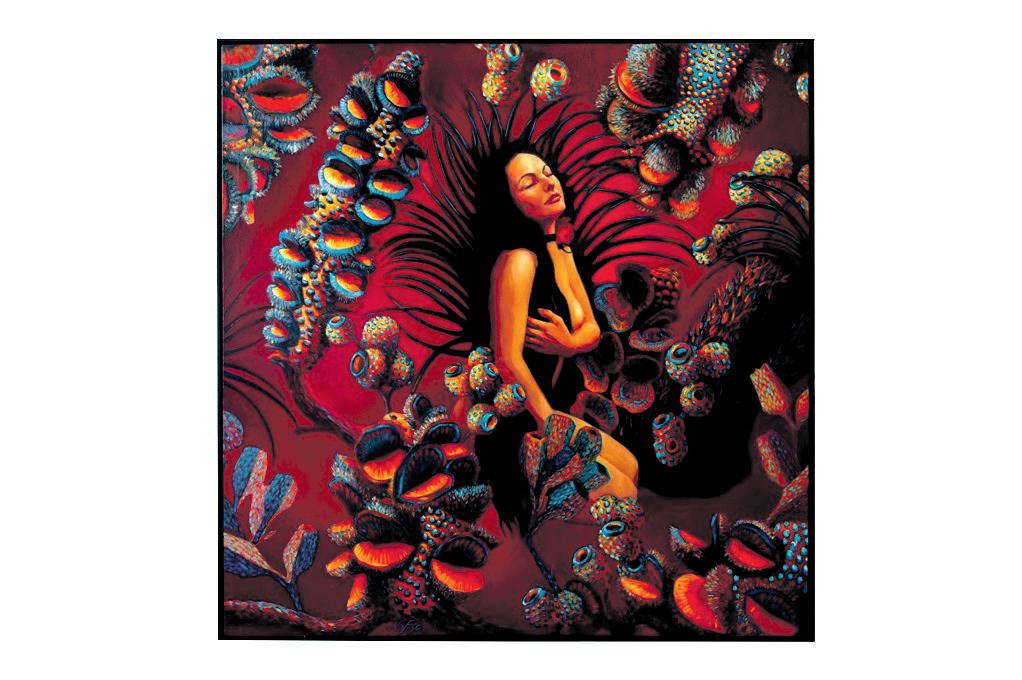

FREE Vol. 19 No. 7 (2) • APRIL (2) 2012 • www.indianlink.com.au • FORTNIGHTLY SYDNEY Indian Link Radio 24/7 on the net Log on to www.indianlink.com.au Indian Link 24/7 Radio 18000 15 8 47 Sydney • Melbourne • Adelaide • Brisbane • Perth • Canberra PAssION of Nafisa Naomi’s latest work Pictures Level 24/44 Market St, Sydney 2000 • GPO Box 108, Sydney 2001 • Ph: 18000 15 8 47 • email: info@indianlink.com.au

2 APRIL (2) 2012 www.indianlink.com.au

APRIL (2) 2012 3 NATIONAL EDITION


4 APRIL (2) 2012 www.indianlink.com.au TUESDAY SPECIAL 30% off on all Main CourseCurries (Dine-in only) DELICIOUS SPECIAL PUNJABI DISHES for weekends OPEN DAILY FOR LUNCH & DINNER Free home/oFFice delivery within 5kms radius... min order $30 Byo (alcohol only)
PUBLISHER
Pawan Luthra
EDITOR
Rajni Anand Luthra
ASSISTANT EDITOR
Sheryl Dixit
MELBOURNE
Preeti Jabbal
CONTRIBUTORS
Noel G DeSouza, Preeti Jabbal, Sandip Hor, Talia Kaur, Farzana Shakir, Rani Jhala
ADVERTISING MANAGER
Vivek Trivedi

02 9262 1766
ADVERTISING ASSISTANT
Nitika Sondhi
02 9279 2004
DESIGN
Danielle Cairis
Indian Link is a fortnightly newspaper published in English. No material, including advertisements designed by Indian Link, maybe reproduced in part or in whole without the written consent of the editor. Opinions carried in Indian Link are those of the writers and not necessarily endorsed by Indian Link. All correspondence should be addressed to
Indian Link
Level 24/44 Market St, Sydney 2000 or GPO Box 108, Sydney 2001
Ph: 02 9279-2004
Fax: 02 9279-2005
Email: info@indianlink.com.au

www.indianlink.com.au
Advance Australia Fair
As ANZAC Day approaches, it is heart-warming to see many expressions of national pride around us. While this special day reminds us of similar occasions from our country of origin, it also acquaints those amongst us who are newer arrivals to Australia, of significant aspects of the Australian national psyche.
Most Indian Australians who migrated here in their mid-twenties will probably be able to sing the Indian national anthem Jana Gana Mana in their sleep, but most will only mumble through the words of the Australian national anthem Advance Australia Fair. Witness any Indian national day function when the time arrives for the national anthems: either young children are marched out who sing the Australian anthem having learned it at school, or a taped version takes care of the formalities.
While the need for the local Indian Australians to learn the song, especially as they settle in their new country, is a discussion for another time, one needs to look at the issue of whether we as a nation underplay our national pride through a subdued exhibition of our national symbols of the flag and our national anthem.
There is still a considerable debate on the acceptance of our current national flag and anthem. There is a strong feeling that the flag represents invasion by the British and the national flag should reflect Aboriginal heritage. National Party Senator Sandy Macdonald said in 2001 that Advance Australia Fair is so boring that the nation risks singing itself to sleep, with boring music and words impossible to understand. Others believe that Waltzing Matilda represents the spirit of true Australia. Both the lyrics and melody of the official anthem have been criticised in some quarters as being dull and unendearing to the Australian people
Be that as it may, till these issues are resolved, it is important that all Australians respect our national symbols and we as a nation take more pride in them.
True, at this time of the year the national symbols are more visible, but
perhaps they should be equally visible at other times of the year as well. Watching a baseball game at the Yankees stadium recently, one was struck by the fervour with which the national songs were sung at various times during the evening. A special moment set aside to remember the serving armed forces personnel was just as touching. One wonders whether such expressions of national sentiment would go down well in Australia.
Speaking from the perspective of a migrant community, they certainly would help in bringing in a heightened feel of allegiance to one’s adopted country.
The flag also needs to be a stronger brand for a growing nation. Other than public structures such as the Parliament House or the Sydney Harbour Bridge, there needs to be a more public display of the national flag. Around the concourse of the Opera House? Along the promenades of Darling Harbour?
In public parks in Harris Park or Cabramatta? A bit more investment in the public display of the flag will allow the melting pot of the various cultures of Australia to solidify into one sentiment proudly Australian.
Time for all of us to demonstrate our affiliation to our adopted country.
APRIL (2) 2012 5 NATIONAL EDITION EDITORIAL
Priyanka Tater, Jyoti Shankar, Dolly Singh Miranda, Yogi Savania, Indira Ghosh, Ritam Mitra, Pranav Shivashankar,
PAWAN LUTHRA
INDIAN LINK
SPIRITUAL Bhagavad Gita classes by SVT
Learn Chapters 7 to 13 of the Bhagavad Gita as taught by Sri Vasudevacharya, a senior disciple of Sri Swami Dayananda Saraswati, and a respected Vedanta Guru. Commencing 4 March 2012, on first three Sundays of each month, and concluding 9 September 2012, at Darcy Road Public School Hall, Darcy Road, Wentworthville, 3:00pm to 5:30pm
No prior knowledge is required. The course is in English and all materials will be provided. The course is free of charge; donations are accepted.
Details at www. srivasudevacharya.org
Shree Ram Sharnam society
The Shree Ram Sharnam society’s Sydney headquarters are located at 23 Sheba Crescent, South Penrith. One-hour prayer sessions featuring the recital of the Shree Amritvaani are held daily between 7:30pm and 8:30pm (except Saturday and Sunday when prayers are held from 6pm to 7:15pm). The society’s
What’s on
next prayer-meditation sessions are scheduled for April 1, May 13 and June 3 from 9am to 10.00 am at the Woodcroft Community Centre on 65 Woodcroft Drive.
Swami Sivananda –Man to God-Man
Sat May 5, 5:45pm onwards at Marana Auditorium, 16 MacMahon Street, Hurstville, Sydney. An inspiring drama based on the life and teachings of one of the greatest saints of the 20th century. Organised by the by Divine Life Society of Australia (DLSA). For tickets, please contact Dr. Asha Gupta on 9764 6604; Gunvant Vaghela on 96883312 or Vijay Gokarn on 0411450321.
FUNDRAISERS
Mother’s Day dance for charity
Sat 12 May SOUNDWAVES, a popular group of communityminded people, announce a dance event on Mother’s Day, to raise funds for children’s welfare programs in Somalia and Sudan. Harvey Lowe Pavillion, Castle Hill, 7.00pm. Details Nicky Pillai 0418 276 120
MISC
Hindi studies for high school students
Hindi Language is offered by the Saturday School of Community Languages - DET at Liverpool Girls High School, Hills Sports High School and Strathfield Girls High School. This provides opportunities for high school students to study Hindi language to Higher School Certificate levels as it is not available at their day school. Board of Studies syllabus is followed. The classes are free of charge and are run on Saturdays from 8.30 am to 10.30 am for Years 7 – 10, and 8.30 – 11.45 am for Years 11-12. Enrolment forms can be accessed from the School Principal of the mainstream school of your child or can be downloaded from www. curriculumsupport.education. nsw.gov.au/secondary/ languages/sscl/ Details 02 9886 7505; Saturdaycl-h.School@det.nsw. edu.au
Hindi language symposium
Wed 2 May, 2:30 – 4:30 pm at NSW Parliament House: International Hindi Language Teaching Symposium /
Letters to the Editor
The importance of India’s zero
Dear Editor,
The following is an important news update. It is, in fact, announcing history!
I had thought podometic was to be an important and long overdue update of the Hindu number system. However I have just had two mathematics professors confirm that when I launch my free e-books in India, I will be correcting a mistake in mathematics that has lasted 2300 years! Please let me explain...
In the west, one of the world’s most famous mathematicians is Euclid. He wrote a series of books called The Elements, which is second only to the Bible for editions published. Euclid wrote The Elements in 300 BC. In it he defined
multiplication (Book 7
Definition 15) as: “A number is said to multiply a number when the latter is added as many times to itself as there are units in the former”. This is a 2300-year old definition of multiplication.
The above definition is taught to maths teachers by maths professors all over the world. For example Professor Wu (a research mathematician) wrote the following*: “Sometimes we refer to ‘mk’ as the product of ‘m’ and ‘k’, and call ‘m’ and ‘k’ the factors of ‘mk’. We call attention to the fact that ‘mk’, the multiplication of ‘k’ by ‘m’, is a shorthand notation for adding ‘k’ to itself ‘m’ times, no more and no less. Please be sure to impress this fact on your students.”
One of the reasons I was confused by maths as a child was that it appeared illogical
Workshop – Ashok Chakradhar 18 May, 3:30 – 5:00 pm at Parramatta Town Hall, International Hindi Grammar Teaching- Current State and Direction- a symposium by Bageshri Chakradhar Bhavan Australia has invited Dr Ashok Chakradhar (a wellknown Hindi poet and scholar), Vice Chairman, Central Hindi Institute, Ministry of Human Resources Development, Government of India; and Dr Bageshri Chakradhar (a wellknown poet in her own right and Hindi scholar), Associate Professor, Shaheed Bhagat Singh College, University –deputed by University Grant Commission, Government of India to preside over symposiums on the Hindi language.
Star Gazing at Parramatta Park
Sat 28 April Come along and share the mystery of our place in the universe at Parramatta Park’s popular Star Gazing @ Parramatta Park. There will be up to 20 telescopes provided by members of the amateur astronomical societies who will be there to share their knowledge with you, or you
can bring your own telescope and get pointers on its use from fellow enthusiasts.
5.30pm to 8.00pm. Dr Ragbir Bhathal of UWS will be presenting a talk entitled ‘The scientific achievements of the Parramatta observatory’, at 6.00pm. Details Susan Clunie 02 8833-5020.
OzSpell Challenge
OzSpell Challenge, a new Australia-wide spelling competition, is sponsored by Macquarie Dictionary and targets students aged 1014. The Grand Final will be held at the Seymour Centre, the University of Sydney in August 2012. The Champion of Champions (based on one district finalist from each of 150 Australian federal electorates) will take home $5,000 cash and $5,000 cash for their school’s library resources. Details visit www. ozspell.com.au or calling 1300 ozspell (1300 697 735).
Sydney Sakhi Sangam
Sun 24 June Sakhi Sangam will be held this year at the Croatian Club. Details Nandini 0423 684 340, Susham 0411 967 374, Aruna 0410 338 900.
to me. If three times four was three added to itself four times as 3 + 3 + 3 + 3, than why are there only three addition steps and not four? There are only three addition signs. Of course everybody knows that 3 x 4 = 12, yet the repeated addition in the equation was not logical. So Professor Wu and other professors write books for maths teachers to teach children something that seems odd to children.
However, in my opinion, Euclid’s formula for multiplication used for the last 2300 years is wrong! The repeated addition is not to ‘itself’, it is to zero. I wrote to Professor Joyce, one of the world’s leading experts on Euclid to ask how could Euclid be wrong? I said that ‘mk’ is ‘m’ added to zero ‘k’ times. (mk is ‘m’ added to itself, ‘k’-1 times).
So 4 x 3 = 0 + 3 + 3 + 3 + 3, and now it makes sense as there are four addition signs.
Professor Joyce reminded me that Euclid didn’t think of ‘zero’ as a number as it hadn’t been invented yet. That was to come about 900 years later in India.
So this is amazing news! The world had not updated its definition of multiplication for 1400 years since the creation of zero in India! That is one reason why children dislike mathematics around the world!
Professor Joyce has now corrected Euclid’s definition for multiplication on his website after I wrote to him. So when we release our stories, we will now be able to joke that Podo the Puppy is smarter than the world’s most famous mathematician in history! Seriously,
nearly all dictionaries say multiplication means “added to itself”, rather than added to India’s zero.
What is 1 x 1 according to Euclid? One added to itself one time, which is two. Wrong!
What is 1 x 1 according to us? One added to India’s zero one time which is one! Right! Nobody knows this in India, yet they will soon! The world will soon focus its attention on India’s zero because they forgot to do so after it was translated into Arabic, Latin and English.
Jonathan Crabtree
Author, Podometic e-books
*http://math.berkeley. edu/~wu/EMI1c.pdf
DRAFT of his latest book
“Understanding Numbers in Elementary School Mathematics”
6 APRIL (2) 2012 www.indianlink.com.au
Sonu’s spectrum
simply makes magic on stage, as if his raw energy creates different works of art each time he performs live.
BY PRiYANk A TATER
Sonu Nigam has often said in interviews that if not a singer, he would have been a scientist…in that case the music world would have experienced a huge vacuum! For someone who unabashedly took to the stage at just 3 with a rendition of ‘Kya hua tera vaada’, the song that got Mohammed Rafi his first and only national award, music was destined to happen. This talented musician had his share of struggles before finding a foothold in the Bollywood music scene, but the hurdles made his success taste even sweeter.

And here I was at the Sydney Olympic Park, ready for the man who is known as the bridge between the legacy of the past and the power of today - Sonu Nigam! The queue outside the gates snaked around for almost half a kilometre, an indication that his two previous performances in Sydney hadn’t wearied his fans, who managed a full house yet again.
Though initially it was a screechy-sounding high-pitched Sydney-based anchor who made most of us miss our earplugs, thankfully Sonu Nigam had included an MC in his troupe for the rest of the evening. After an initial performance by dance group Road to Bollywood, and some sensational singing by US-based singer Gunjan, the magic voice of Sonu Nigam filled the air with very tempting teasing mix of ‘Kal ho naa ho’ and ‘Shukraan allah’. Then Sonu walked in, dressed in black harem pants, a figure-hugging black t-shirt and a jacket, crooning the latter half of that song from Kurbaan, followed by ‘Rab raakha’ from Love Breakups Zindagi. Claps, whistles, and swooning young girls greeted the star. He returned the favour with a quick “Salaam, Namaste!”, telling the crowd that he would sing first and then chat. And with that he launched straight into ‘Mera rang de basanti chola’ from the Legend of Bhagat Singh, his favourite for the past 10 years.
Now you may have heard Sonu Nigam’s songs on CDs, in movies and on the radio, but his true potential is when he performs live in concert. Not one of his songs sounds the same. The variations are unbelievable, the notes, pitch, harmony, melody, rhythm – Sonu
After hooking the audience, he moves on to ‘Ajeeb ittefaq hai kya mukalaat hai’, while the audience is in splits. Finally after a bit of fun, he starts all over again this time singing the correct lyrics, ‘Ajeeb ittefaq hai kya mulakaat hai…don’t say alvida!’
From ‘Gum sum gum sum rehnewaali’ (Dabangg) to Phir milengey chaltey chaltey (Rab ne bana di Jodi); from To aaja tu hai pyaar mera (Teesri Mazil) and ‘Mere sapno ki raani’ (Araadhana) to ‘Bachna ae haseeno’, Sonu Nigam treated the crowd to some non-stop evergreen classics. He even asked if the audience was game to continue until 6am, then quipped about the arena belonging to his ‘chacha’, inviting peals of laughter yet again!
On ‘Bole chudiyaan’ (Kabhi Khushi Kabhi Gum) and ‘Mahi Ve’ (Kal ho na ho), the crowd let down their hair and danced right in front of the stage. And ‘Saathiya’ got the audience into singing mode.
From singing to rendering the beautiful sufi song ‘Tu hi tu satrangee re’ (Dil se) to his unique introduction of his band, Sonu Nigam proved yet again that he ain’t just a singer, but a performer and a mesmeriser.
He then reminisced about his musical journey to fame, in a conversation with the audience. Sonu recalled how it’s been 21 long years in Mumbai since he started his musical career, and despite only cricketers and movie stars getting all the accolades and fame, he was lucky enough to break that norm. His third trip to Sydney is proof that music connoisseurs love him.
“Everyone’s taste is different, so I am trying to incorporate as many songs to cater to everyone,” said Sonu Nigam and he stayed true to his promise. From soft melodies, dance hits, sufi music and his extremely popular album song
‘
Tujhe laage na najariya’, the maestro showed a taste of his versatility.
It was an euphoric experience when Sonu sang unplugged renditions of some of the greats like Rafi, Manna De, Mukesh and Kishore Kumar. ‘Raat ke humsafar’ (An evening in Paris), ‘Ye raat bheegi bheegi’ (Chori chori, 1956), ‘Pukaarta chala hoon main’ (Mere Sanam), ‘Bekaraar dil tu gaayeja’ (Door ka rahi), ‘Geet gaata hoon main gungunaata hoon main’ (Lal Patthar), ‘Aa Jaane jaa’ (Intequam), were tributes to these legends. He even mimicked the likes of Udit Narayan and Kumar Sanu.

Yes, Sonu Nigam is not just a singer, but a great host, performer and mimic too. There was not a dull moment with the legend putting in his heart and soul into entertaining the music lovers around him. Be it the extremely soulful ‘Tanhaai’ (Dil Chahta Hai) or ‘Tera jadoo chal gaya’, he made melodic montages of as many songs as he could. After nearly 3 hours of a non-stop performance, this bundle of talent was still bubbling with energy when he asked us “You are not tired…aal izz well?” - and we knew exactly what treat we were up for next! Sonu made the original song in the movie sound like a miniature version of the one he sang on stage, with all his antics and creativity!

And then he still had the energy to cater to all the requests of songs in Kannada, Gujarati, Marathi, Punjabi, Bengali etc. Through just a couple of lines for each, he tried to please everyone and was successful at that.
Of course ‘Sandesey Aate Hai’ (Border) gave me goosebumps while his record-breaking song from Tees Maar Khan in 54 different voices simply bowled me over yet again.
And then came his classic from the new Agneepath, ‘Abhi mujh mein kahi baaki’ which he sang only after making us realize how good we had been as an audience!
“After almost 3 hours of singing this song is very difficult to croon. I only sing this song when I feel the audience deserves it,” he said, and we were blessed!
Come to think of it, its difficult to pen the number of songs he sang, but the final master stroke of ‘Kal ho na ho’ was a fitting finale.
Now this review may appear over-eulogised, but with good reason. After having seen a number of stage performances by various other artists and maestros, I never could differentiate much between their recorded versions and their live ones. But with Sonu Nigam adding that extra dose of all those impromptu variations and the novelty in his music, I was thankful to be at his concert.
Three cheers to the organisers Cine Starr for making it a success, the third time around. Though I sincerely hope that next time, music lovers attending are not just restricted to the Indian community.
After all, music transcends boundaries and the world needs to look beyond AR Rahman.
From soft melodies, dance hits, sufi music and his extremely popular album song ‘Tujhe laage na najariya’, the maestro showed a taste of his versatility.
NATIONAL EDITION m AI ns TREA m
The variations are unbelievable, the notes, pitch, harmony, melody, rhythm – Sonu simply makes magic on stage, as if his raw energy creates different works of art each time he performs live.
This versatile musician proves that he is much more than just a song and dance man
Yoga, dance, craft make workshop fun
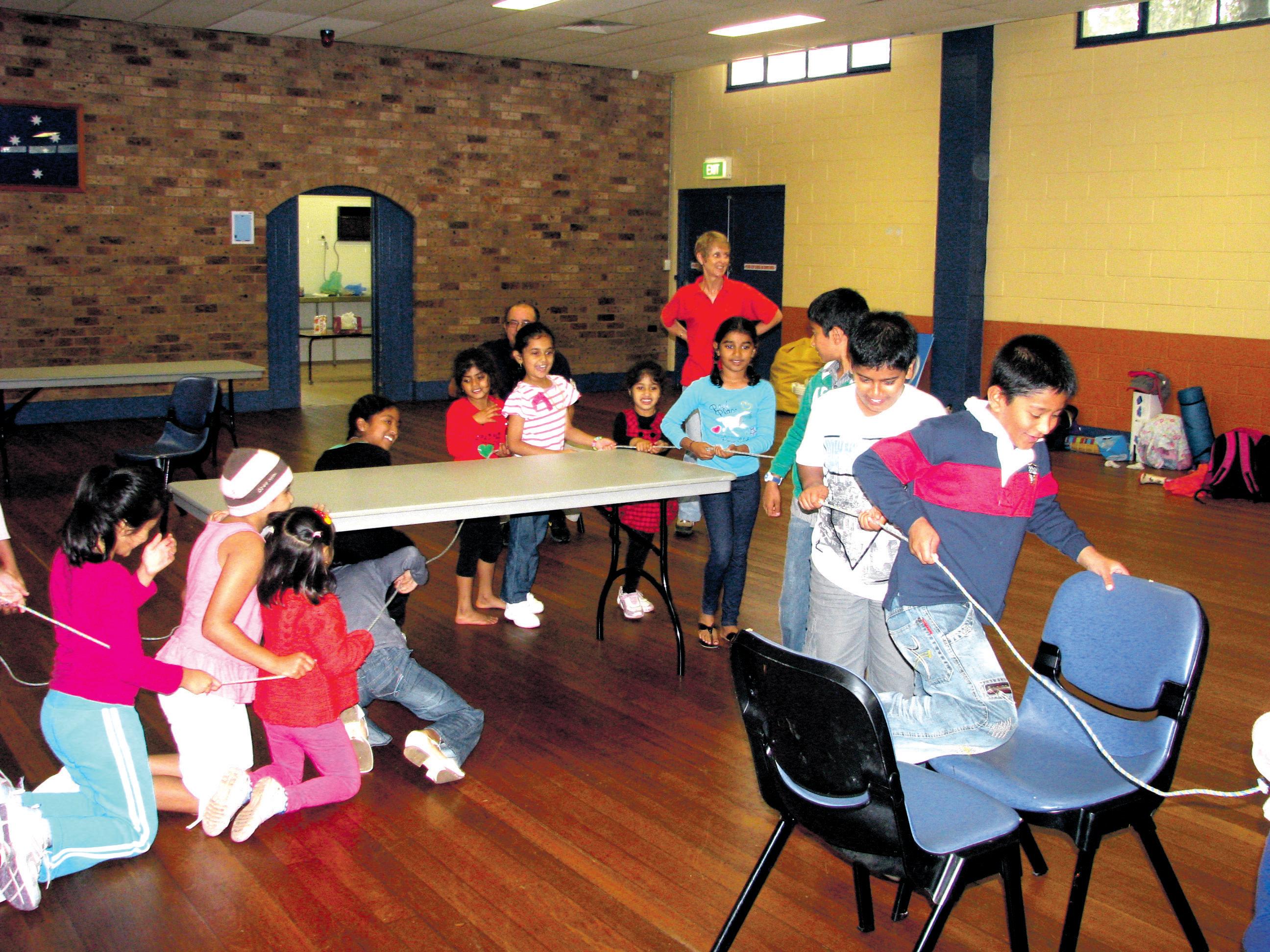
The Indian Arts And Film Association (IAAFA) conducted a very successful Children’s Holiday Workshop between April 16-20. During five fun-filled days of activities, children from 5 to 14 years of age, were inducted into a range of activities which were designed towards improving their social skills and giving them a chance to develop their potential towards future opportunities.


Their enthusiasm was apparent as the children arrived bright eyed and happy each morning to begin the day with a hearthealthy yoga session conducted by professionals in the yoga industry. Apart from yoga, the children
were exposed to a wide variety of dance techniques including line dancing, Bollywood dance and pop dance, to name a few. They were also able to harness their artistic and creative abilities as they eagerly participated in arts, crafts, jewellery and clay modelling lessons, creating their own mementos from these classes, and showing them to their admiring parents. In addition, the children had the opportunity to present their own vocal talents in a singing activity where they learnt how to improve not only their singing, but also their public speaking and presenting abilities.

A visit from the local Scouts and Guides Club encompassed a series of activities that allowed
the children to learn about the importance of teamwork and co-operation. To expose them to their Australian heritage, a member of the native community was invited to visit the children, and display and explain to them a variety of aboriginal arts and instruments, and their uses.
On the final day, Ms Melissa Monteiro, Executive Director from the Migration Resources Centre and Ms Alison Rahil, Actu Community Organiser presented
coming together and making this programme an outstanding success.”
It was the collective effort of core members of IAAFA -
guest attending, but also by the parents.
They look forward to upcoming events from IAAFA.
Pranav Shivashankar
8 APRIL (2) 2012 www.indianlink.com.au CO mmun ITysCE n E

APRIL (2) 2012 9 NATIONAL EDITION
BY JYOTi SHANk AR
Ifirst met Nafisa Naomi in March 2010, when she had just won the Packing Room Prize for her painting of Glenn A Baker at the Archibald art competition, Australia’s oldest and most prestigious art awards. I remember thinking, “Now, here is somebody who lives life king size!”, and it was not just the size of her paintings that made me think that. It was her vivacious personality and obvious talent. A Sydney-based artist born in Mumbai and raised in Hong Kong and Sydney, Nafisa’s father has a Parsi Indian background, while her mother is Dutch. Less than two years later, she has produced an astounding body of artwork, a series of paintings and sculptures titled ‘PAssION’, which exhibited at the Richard Martin Art Gallery at Woollahra recently. The paintings were well-received with over 200 people attending the opening night.

This substantial body of art covering 18 months of work, breaks new ground by combining painting with sculpture, both in their purest forms. The


play of Passion – the slow build up of this passion from realisation to fulfilment is depicted by the increasing closeness of the female form and the flowers. Australian wildflowers have resilience, toughness, even a masculine side that compliments the feminine figure. Just as Australian native plants thrive when there is a fire, women are tested under fire too. “We suffer adversities and as a result of surviving these we become more mature and beautiful,” believes Nafisa.
Using sculpture as a media was new for Nafisa, and a part of her learning. Her unique technique of using resin with bronze was to bring out the colours from her paintings into the sculptures. The flower petals were created in resin so that she could juxtapose the rich colours of resin with the strength of bronzes. “I could be working with film for my next project,” she says. “My work takes on its own life and does not remain static, though the subject matter is always around beauty and nature. This comes out in different forms, but is new each time.” Nafisa indicates that her strong sense of colour and compulsive use of vibrant colours - so unlike Western artists - can definitely be traced to her Indian roots.

In September 2012, Nafisa will

stop the gradual daily destruction of wildlife and environment happening everywhere. Nafisa literally wishes to ‘draw’ our attention to this matter.

Animal Works is not the only charity with which Nafisa is involved. She participates annually in creating a painting using jeans donated by celebrities. Hugh Jackman, Cameron Diaz, Hilary Swank and Mick Jagger donate a signed pair of their jeans which Nafisa incorporates into a painting of the celebrity which is auctioned at the Jeans for Genes Denim Dinner, an annual fundraiser of the Children’s Medical Research Institute. Last year, Nafisa’s painting with Cate Blanchett’s jeans was purchased by Addisons, the law firm, for $8000.
Working from a studio in Mosman, set amid the beauty of natural bushland with Sydney Harbour as a backdrop, it is easy to see where her inspirations come from. Nafisa’s award-winning paintings of native Australian flowers and plants, Regeneration, won a gold medal at the Florence Biennale in 2007, chosen from over 800 entries by artists from 60 nations. A wellspring of beauty and talent, Nafisa seems to live the words of Nelson Mandela, “There is no passion to be found playing smallin settling for a life that is less than the one you are capable of living”.
of PAssION Perceptions

two art forms sit besides and compliment each other, and while they can exist by themselves, their relationship essentially completes the other. Nafisa confesses that PAssION is largely autobiographical. They reflect relationships of all kinds: manwoman, parent-child and with non-human entities, such as a passion for painting or music. The sentiment that the artworks convey is more of reflection than regret, though the titles suggest otherwise. As Nafisa says, “I never regret anything in life. All life experiences are a part of learning by reflection.”
Australian flowers are often featured in Nafisa’s work. “In this exhibition too, they are a metaphor for passion,” she says.
“As we discover and pursue our passions, the more it becomes a larger part of our life, to the extent that you feel you cannot breathe without it.” In the paintings – a series of Acts in the
be one of the 30 artists selected from over 8000 artists to exhibit at the Chianciano Museum of Art at Tuscany. From there she heads off to Zimbabwe on an African safari with Dr Tammie Matson, to raise money to build a school there. Late last year Nafisa was in Assam with the Wildlife Trust of India and Dr Matson, following the trail of orphaned elephants released into the wild. Her elephant series of drawings done after an earlier visit to Assam to research and document human-elephant conflict, are realistic and detailed. Prints of these are sold by Animal Works, an organisation that is a coalition of artists, filmmakers, authors and conservationists who try to draw attention to the plight of threatened animal species through written word, visual medium and artwork. She rues the facts that we wake up to major disasters such as tsunamis or earthquakes where many lives are lost, but do little to
s p ECIAL F EAT u RE
1 2 6 7 8 10 APRIL (2) 2012
PAssION
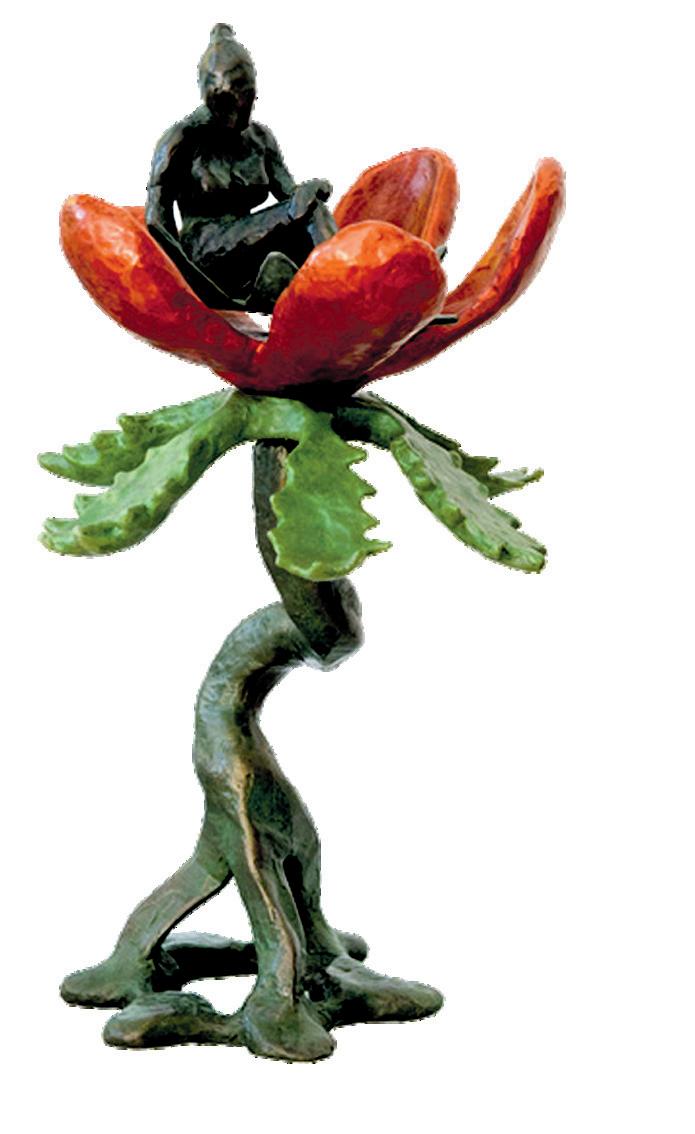



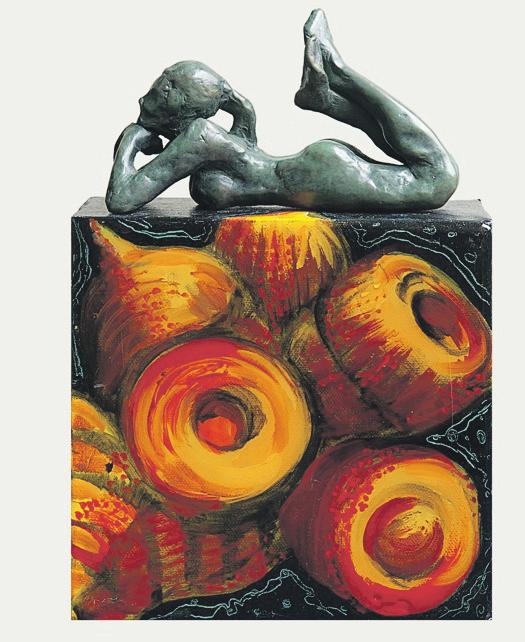


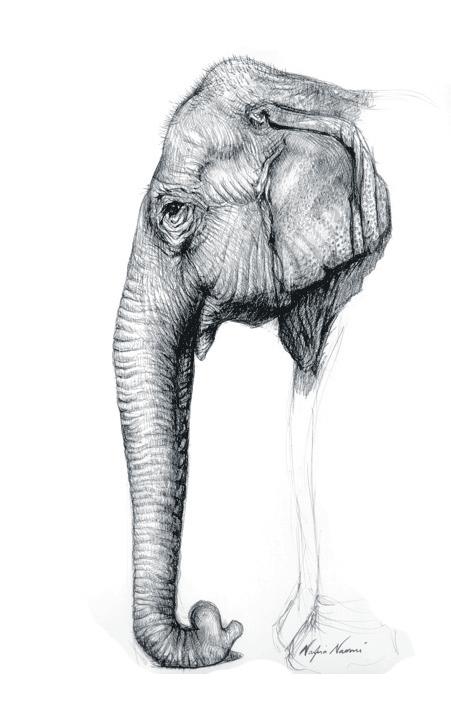 Top half: (clockwise)
1. Glenn A Baker portrait, Archibald entry, Packers Prize winner
2. Rumour Has It
3. Borneo 10
4. Elephant portraits
5. Nafisa and orang-outang sketch together
(from left)
7. Passion 1 Act IV
8. Black Burn
9. Sitting in the Passion flower
10. One of These Days You Will See Me Again
Cover visual: Let me be your one and only
Top half: (clockwise)
1. Glenn A Baker portrait, Archibald entry, Packers Prize winner
2. Rumour Has It
3. Borneo 10
4. Elephant portraits
5. Nafisa and orang-outang sketch together
(from left)
7. Passion 1 Act IV
8. Black Burn
9. Sitting in the Passion flower
10. One of These Days You Will See Me Again
Cover visual: Let me be your one and only
3 4 5 9 10
Vaisakhi enlivens Parliament House
Come to Sydney and see the world!” said Mr Harjit Sethi, Vice Consul (PS) to the Consul General of India in Sydney. He was speaking on the occasion of the seventh annual Vaisakhi celebrations held at Parliament House in Sydney, truly symbolizing diversity and acceptance as it marked the coming together of two cultures in perfect harmony.
It was breathtaking to see beautiful Sikh prayers being offered to initiate the ceremony at the backdrop of the stately Parliament House. And even more wonderful to see Ministers and Members of the Parliament bow
their heads in reverence to these
The evening started with Shabad – religious hymns from the Guru Granth Sahib, the Sikh holy book, lead by Dibjot Singh of the Sikh North Shore Youth Choir.
Dr Moninder Singh, Coordinator of the Punjabi Council, gave the welcome address.
This was followed by the Pride of Punjabi Awards presented to Hon Kanwaljit Singh Bakshi, First MP for the NZ Parliament; Mr Kulbir Singh Suri, acclaimed Punjabi writer; Mr Bawa Singh Jagdev, responsible for building the Gurudwara in Austral, NSW; and Mr Jagmandeep Singh, a budding sportsman.

Hon Minister Victor Dominello, Minister for Citizenships and Communities spoke about the importance of multiculturalism, with a clear message on celebrating diversity.

The Hon John Robertson, Leader of the Opposition stated that it was a real honour to be part of the celebrations. He mentioned the immense contributions by the Indian community to the Australian economy.
Also attending the celebrations were Shelly Hancock, Speaker of the Legislative Assembly and the Hon Adrian Piccoli, Minister for Education.
Vaisakhi is the most important of festivals for Sikhs, and
Award winners
denotes the beginning of the harvest season, as well as the creation of ‘Order of Khalsa’ by Guru Gobind Singhji in 1699. Celebrations in northern India are marked by colourful costumes worn by farmers and dancing to the beat of drums. However, the dancing in Parliament House could have been set in any village in Punjab, with a group of
children in colourful costumes gyrating enthusiastically to bhangra!
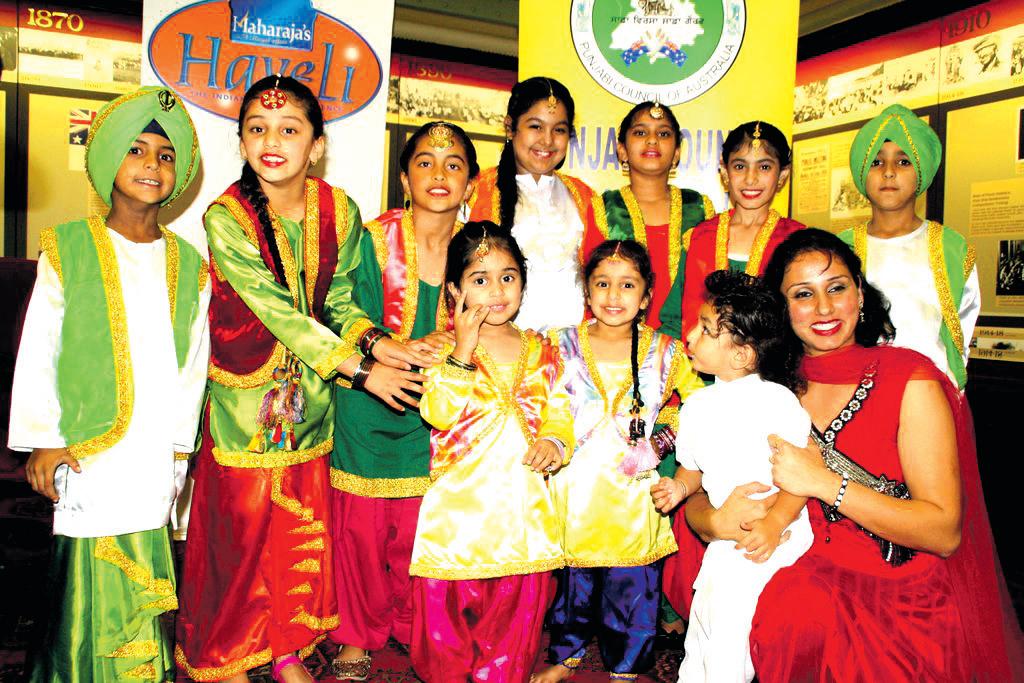
A grand evening, which marked the growing relationship and synergy between Australia and India. A big pat on the back for the Punjabi Council lead by Dr Moninder Singh, for achieving this milestone!
As a Sikh married to Catholic
Indian, this celebration was particularly significant for me and my family, as we strive to inculcate the best of our traditional and religious heritage in our marriage and for our children.
My 4 year old son and 2 and a half year old daughter also enjoyed a glimpse into the richness of this vibrant festival.
Dolly Singh Miranda
12 APRIL (2) 2012 www.indianlink.com.au CO mmun ITysCE n E
Young bhangra dancers
Hon. Minister Victor Dominello







APRIL (2) 2012 13 NATIONAL EDITION
Top of the world
fundraising opportunities, as well as approaching corporates and event partners to help Whitelion in gaining sponsors.

For Ajay, it’s the feeling of being able to help young people that is at the crux of his involvement with Whitelion. “I have always felt a connection with young people, and when I came across Whitelion, I realized that I felt inspired by their initiatives to help disadvantaged youth,” he says. “In fact, I feel that people in the community should make an effort to volunteer their time to a good cause. Get involved in a cause to which you feel close, the feeling is just great!”
It was an amazing rush of adrenalin that made Ajay Unni practically run down the slope to the base of the last peak, with the knowledge that he had successfully completed the Whitelion 3 Peaks Challenge in 32.5 hours. The feeling of exhilaration continues as Ajay recounts his experience in scaling Mt. Tenant, Mt. Kosciuszko and finally Mt Bogon, in essentially 23 hours of climbing and the remaining ten hours of travel and resting.
The fundraising challenge on behalf of Whitelion began on the morning of March 23 at 7am, and ended at 4:30pm on March 24.
“The first peak was a challenge, but my training since the past few months held in good stead. I managed to get to the top of Mt. Tenant without much difficulty. However, it was the second peak that posed the biggest problem,” recalls Ajay.
“It wasn’t easy,” he admits.
“It took me 7-8 hours to climb Mt. Kosciuszko in rain, hail and freezing wind, and my food and

water were frozen solid. I didn’t eat anything for over seven hours. That’s when I had to ask myself what on earth I was doing scaling a peak in these extreme conditions.” But despite the hardship of the actual climb and without food or water, Ajay made it back to the welcome warmth of the camp and a cup of hot soup. And before long, it was time for the third mountain challenge.
After the adversity faced when climbing the second peak, Ajay was more than ready to tackle Mt Bogon. “Conditions were better and I had no problem in reaching the peak. But I practically ran all the way down,” he says with a laugh, recalling the feeling of joy and excitement at having successfully completed the challenge.
Ajay trained every day in all weather conditions for a couple of months before undertaking the challenge. “The good thing is that I actually enjoyed the physical activity and have continued the routine of jogging and exercising even now,” he says.
Naturally, all the people who
supported Ajay in achieving the challenge were as thrilled as him.
“My family, specially my wife Sapna has been a pillar of support whenever I decide to participate in any fundraising activity,” says Ajay.
“This time around she is doubly happy as I lost about 6kgs when training and doing the challenge, which is something she wanted me to do.” Ajay is also grateful to those who contributed towards raising money for his challenge.
“I raised a little over $1000 for this event, and it was thanks to the support of all the people who contributed towards the cause.”
Ajay has been involved with Whitelion for some time now, a non-profit community organisation that provides youthfocussed gender and culturally specific services in several areas including employment, role modelling, specialist outreach support and education based prevention programmes. Although this is the first time Ajay has undertaken the 3 Peaks Challenge, last year he volunteered to be a part of the Bail Out initiative, spending a night at a juvenile detention training centre. He continues to help in identifying

There is a general misconception that when it comes to disadvantaged youth, they mostly belong to mainstream Australian communities. However, there are also Indian and other nationalities who fall within Whitelion’s spectrum, who have been convicted for juvenile crime. “It would be great if these youth can also be helped, perhaps by willing members of the community,” says Ajay, citing the example of Mark Ella, former rugby union player who is now on the advisory board for Whitelion. He works extensively with juvenile Aborigine youth, as being of Aborigine background, he understands their situation and the challenges they face. “There may be a better connection as they have the commonality of belonging to the same country of origin, which may help these young people improve and better their lives,” adds Ajay.

So what’s next on the agenda for Ajay? “I fully intend being a part of the 3 Peaks Challenge again next year,” he says enthusiastically. “In the meantime I will continue to help with corporate sponsorship and fundraising. The important thing is to do whatever little I can for these young people. Whitelion is a great organization, and I am happy to be involved in it.”
Sheryl Dixit
14 APRIL (2) 2012 www.indianlink.com.au CO mmun ITysCE n E
Ajay on the climb
Heavy weather conditions
Forum reveals elderly as victims of domestic violence
Every year, police officers in NSW deal with 133,000 acts of domestic violence –that is close to 365 acts per day. If that number is not bad enough already, the police estimate that only one in every three acts get reported.
On March 28, the India Club together with the NSW Police Force, organised a special information session on emotional abuse and domestic violence awareness. Domestic violence is a very sensitive issue and often grossly misunderstood within the community. With the help of the Hills Police, Council and members of Parliament, the evening was a definite success. Even if at the end of the night just one person was more educated about the devastating effects of domestic violence, the forum was well worth the effort.

The evening was about establishing the fact that there is a support network for not just all victims, but also for perpetrators who want help to break out of the vicious cycle. As the Hon. Philip Ruddock, member for Berowra put it, “Regardless of cultural issues, there is a framework of law that we must accept.”

The first step in standing up against domestic violence is to identify that there is a problem. For without a problem, there cannot be a solution. And you don’t have to find the solution on your own. There are a multitude of support groups available to assist the community. Senior Constable Nathan Corbett stressed that every police station is equipped with translation services, so language should never become a barrier in seeking for help. Corbett also spoke of the changing nature of domestic violence, which reaches far deeper than purely physical violence. Physical violence is only a part of domestic violence – financial control, threatening, property damage and of late, even social media abuse such as Facebook stalking is all part of domestic violence. Corbett stressed that


the police will take all complaints seriously and advise accordingly.
A gross misconception is that domestic violence is limited within the confines of a marital relationship. The truth is that it can exist in any human relationship. A growing concern within the Indian community is domestic violence towards the elderly. The population of elderly migrants is growing as people bring their aging parents to live with them. In some cases, the elderly parents become little more than convenient commodities, babysitters, cooks and cleaners. Expectations are set and when they are not met, fights break out gradually breaking the confidence of the victim – and often the perpetrator doesn’t even know that they are doing it.
The evening also posed an opportunity for the attendees to ask questions in a panel discussion with the Police and Counselling Psychologist Shobha Yadav. Ms. Yadav highlighted how important it was to seek help before it becomes too late.
“A relationship survives on three pillars; trust, respect and love. All three need to be there for a relationship to work,” she stated. It is important for both parties to be present in counselling sessions for effective resolutions. Often a range of factors contribute to the act, and we are left focussing on the symptoms. A counsellor can help you sieve through these symptoms and pinpoint the root cause which can lead the way towards rebuilding the relationship.
The biggest message against domestic violence, however, came from the attendees. A sombre group of over 100 people in all age groups attended on a weeknight, after their work commitments. This in itself speaks volumes about how serious the issue is, and the collaborative community commitment to stamp this out.
Shubha Kumar from the India Club worked tirelessly to make this event possible, and a special mention to Maya da Dhaba for sponsoring the event
and delighting everyone with the delicious meal after the seminar.
As youth ambassador for White Ribbon Day Divya Dhingra aptly put it, “Domestic violence is the invisible epidemic of our time.” So let’s stand up, take notice and
say ‘No’ to this silent killer.
If you need help with any issues relating to domestic violence, there are many avenues of help available. You can call NSW Police for assistance. You are not alone, the community
stands by you.
The India Club is a unique social group that meets every second Sunday of the month. Visit www.indiaclub.com.au for more information.
indira Ghosh
APRIL (2) 2012 15 NATIONAL EDITION CO mmun ITysCE n E
Shubha with Castle Hill Police Superintendent & State MP David Elliott
Police Superintendent, Deputy Mayor & Mayor of The Hills
Panel speakers
Philip Ruddock with Aksheya, Chairman of India Club Panel
First indian Liberal to contest ACT elections
The next year or so promises to be an extremely interesting period on the Australian political front. Given the scale of the fight ahead and the events that have transpired in Canberra in the last few months, when the election is called, it will definitely be a hugely anticipated one. It’s easy to get caught up in the hype over the possibility of a new leader for the country – but it’s important not to overlook the fact that it will begin with a series of smaller, albeit no less intense, battles on the local stage.
The Canberra Liberals recently finalised candidates for the territory’s October 2012 election, for which there will be 17 seats up for grabs. The party will be creating some of its own history when its first candidates of Korean and Indian origin will be amongst the names on the ballot sheet in October. Jacob Vadakkedathu’s will be one of those names, and for him, it is yet another feather in the cap following an already distinguished
history of community service.
Indians are the fourth most prominent migrant nationality in Australia, behind only the UK, neighbours New Zealand and China. In 2008-09, Australia’s Indian-born population recorded the fastest growth of any group in the country, increasing by a phenomenal 17%. In the most recent census, over 340,000 Australian residents identified as Indian-born, and for the secondmost represented non-Anglo community in the country, it is welcome news that the Liberal Party of Australia is welcoming its first Indian candidate, after almost 70 years since it was founded.
Given Australia’s reputation for being a multicultural society, and a correct one at that, the under-representation of MPs from a diverse range of cultures is somewhat surprising. In the 2006 Census, 24% of residents were reported as being born outside of Australia – yet Penny Wong, Australia’s current Minister for Finance and Deregulation, became the first Asian-born Federal Minister as recently as 2007.
All changes begin with a single step, though, and it is a commendable achievement for the father of two. Jacob was born in Kollam, Kerala, and came to Canberra in 1998, completing his Masters at the University of Canberra, all the while remaining involved actively in the community. He is currently the President of the Federation of Indian Associations of the ACT (FINACT), the umbrella
body of all Indian associations in the territory. Meanwhile, he holds the position of Secretary with the Gungahlin Community Council, is an executive member of the Canberra Multicultural Community Forum, and has also volunteered with the ACT State Emergency Services.


Jacob will be amongst three other candidates, as well as two incumbent members of the Legislative Assembly, representing
the electorate of Ginninderra, and is looking forward to campaigning and meeting many people in the process of doing so. Currently working for the Australian government in the Department of Finance, Jacob will be part of a team headed by leader Zed Seselja, who was looking forward to the upcoming election.
Mr Seselja said the new candidates would add to the “strong and unified team in the Assembly”’. “Along with the diverse experiences of our team, we have many cultures represented including what we believe are the first candidates of Indian and Korean background to run in an ACT election,’’ he said. ‘’They have close ties to their local communities and are committed to our plan of being the best local government in Australia. Although becoming a candidate is a difficult enough task, the journey is just beginning for Jacob – for he could well be celebrating another slice of history in October this year. Congratulations are already in order, but it is time to look forward and aim for the sky - good luck, Jacob, and happy campaigning!
Ritam Mitra
16 APRIL (2) 2012 www.indianlink.com.au CO mmun ITysCE n E


APRIL (2) 2012 17 NATIONAL EDITION APW FINANCE We offer loans from all banks & non-bank lenders Please call 4 home & investment loans up to 95% lvr* 4 refinancing of existing home loans 4 no doc loans up to 80% lvr for self employed* 4 Business & commercial loans 4 self managed super fund home loans 4 seniors equity release home loan to unlock your property’s value and top up your retirement income with extra cash* www.apwfinance.com.au anupa: 0431 513 949 anupa@apwfinance.com.au H home loans H no doc/lo doc loans H Personal loans H car loan/equipment finance H credit repair Mention this advertisement and if loan is approved and drawdown get $500 vouchers from Coles or Woolworths *condition applied min.loan size $300,000. *conditions apply For expert coaching in Lowest Fee Guaranteed IELTS ENGLISH GURU Suite -1, 71 A Macquarie St, Parramatta, Phone 0411 520 546, 9687 9741 www.englishguru.com.au • Power Packed Sessions. • One and Two Weeks Crash Courses Available. • Money completely refundable, if not satisfied with the first tuition session
Sikh comedian smirks at stereotypes
Adelaide recently held its annual Fringe Festival, a 24-day celebration of cabaret, comedy, dance, theatre, music and visual arts events. It is the secondlargest in the world, behind only the Edinburgh Fringe Festival held in Scotland. However, the very nature of fringe festivals is that they are somewhat marginalised –even though the Adelaide festival is indeed such a big event, fringe theatre is quite simply theatre that is not mainstream. This year, Ajit Dhaliwal joined forces with his friend Amy Manuel for his first fringe show, in a comedic duo that turned quite a few heads. Called Ajitating Amy – the lifestyles of the Sikh and Twisted, the pair recently received the Dave Grant comedy grant, which was presented in memory of the Melbourne comedian who sadly passed away in 2010. The grant helps new comics looking for their first Fringe show, and provided Amy and Ajit with three free nights at a Fringe venue, along with assistance in the form of flyers and printing, as well as mentoring regarding presentation and marketing.
Amy and Ajit met during a comedy course, and formed a
friendship as a result. “We did some gigs together and got to know each other more. We just have the same sense of humour ... we were both looking forward to our first Fringe show. We laugh at similar things and we find the whole psychology around comedy very interesting,” Dhaliwal says. “The idea around the show is also about stereotypes and how people judge each other. Even though Amy and I look very different on the outside we’re very similar on the inside.”
The show is a humorous exploration of the duo’s lives and lifestyles – tackling subjects such as a comparison between Sikhs and Jedis, what primary schoolteachers actually think of their kids, and even why Prince Charming isn’t such a great role model after all. The show itself is only 45 minutes long – but in that time, the pair cover ground from England to Australia, crossing Holland and India on the way.
Ajit is described as a laidback, genial personality, and as with all comedic duos, the contrast was important; Amy’s is a dark persona, full of manic energy.
It begins with the pair presenting the audience with a set of words to assign to one of them. For example, “pretty”
(which generally went Amy’s way), and “terrorist” (which often went the other way). And it is in this initial framing of the show that they establish the underlying premise – challenging stereotypes. From this, they begin telling the stories of their own lives, Ajit’s being one of a fashion-conscious Sikh from a big, happy family. He was born in Britain to Britishborn parents, and migrated to Australia only as a teenager. If someone asks him to go back where he came from, he scratches his head and says “Mitcham?”

Meanwhile, Amy’s background is an outer-suburbs upbringing in Melbourne, one that was hardly comfortable and caused her to become angry and lash out at
others, only to eventually find a way out through the literary circuit. If the witty title wasn’t a good enough crowd-puller, the pair’s material was described as edgy and interesting, and in the current social climate where the world is fast becoming a smaller place, challenging ill-conceived and archaic stereotypes has become an important part of society. And there is no better way for us to be doing this than through some light-hearted comedy. Being their first fringe festival, it was a lot of hard work for the pair, according to Ajit.“To do your first show that you’re putting on yourself and producing yourself is quite exciting, but it’s obviously very nerve-wracking at the same
time,” he says. Indeed, some of the performance was still slightly rough around the edges. But the audience and critics alike agree that it would be great to see them around again. Leading critics from the show described the show, in a word, as “amiable” – definitely a successful debut in the tough field of stand-up comedy. Adelaide has already given the duo its stamp of approval, and while it’s unknown whether they will be coming to Sydney Fringe in September this year, it will definitely be worth a visit to some of the venues, from Leichhardt to Surry Hills, to enjoy some of the culture that often slips through the cracks for not being “mainstream” enough.
Ritam Mitra
The O.C. Placement Test for 2013 Entry is in July 2012!
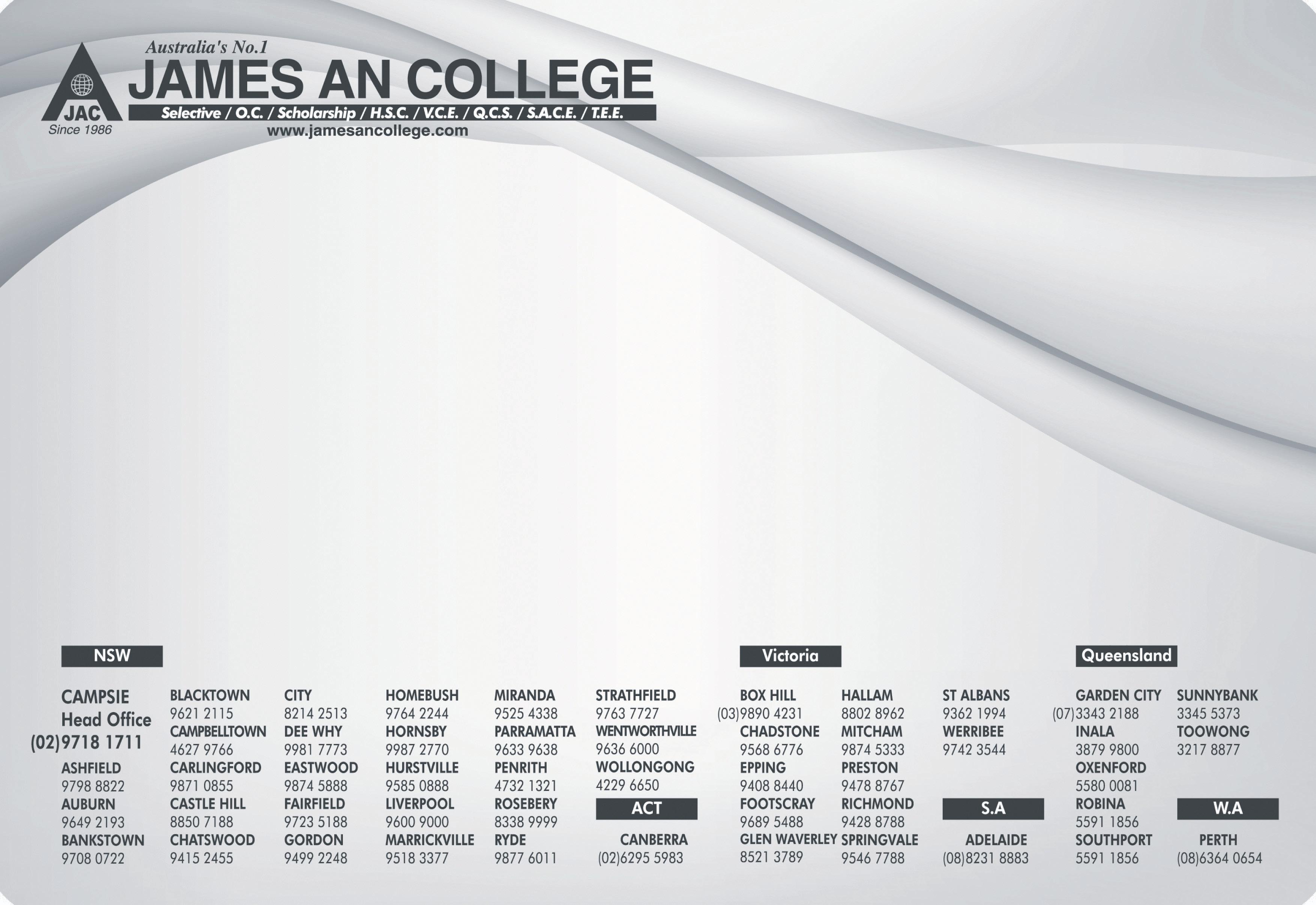
18 APRIL (2) 2012 www.indianlink.com.au
2012 JAC Year 4 O.C. Trial Test Course Only 12 Weeks Left!!! WHEN? This course ends on 15th July 2012 • WHERE? At all James An College branches • HOW? Call your nearest JAC branch to enrol now! HURRY! PRACTICE MAKES PERFECT!!! The more you do, the better you become. It boils down to Competition! Special General Ability ~ (SGA) Selective English & Maths ~ (SEM) Selective Writing Skills ~ Start Date: 19th March 2012 End Date: 3rd March 2013 45 Weeks (Full Course) FULL PAYMENT SPECIAL OFFER: Enrol in all 3 subjects SGA + SEM + SWS before 12th May 2012 & pay only $3990; That’s a saving of up to $3000! *Conditions apply* *Book fees are calculated independently All students who enrol JAC Special Courses will be given individual passwords to get access to our exclusive JAC online trial test revisions! Trial Test Course ENROL NOW and join our growing number of SUCCESSFUL students in the 2012 James An College Year 4 O.C. FuLL pAymEnT DIsCOunT! CO mmun ITysCE n E
inaugural walkathon raises over $6000
OSaturday morning of March 31, BAPS, a community-based charity organisation, hosted its inaugural walkathon in support of medical research.
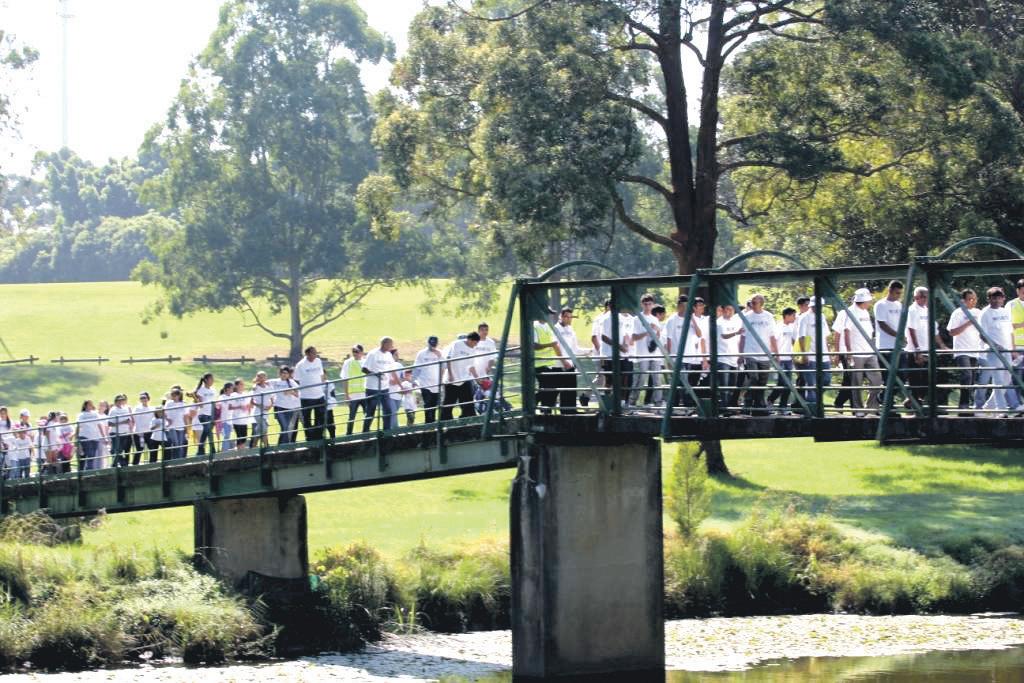
Families, children and seniors all turned out for the 3-kilometre walk through Parramatta Park and its surroundings, in Sydney’s west. Walkers were flagged off by Tyagvallabh Swami, senior sadhu of BAPS, and chief guest for the event the Hon. Phillip Ruddock MP, Federal MP for Berowra, former Howard-government Minister and Shadow Cabinet Secretary.
Mr Ruddock, representing the Federal Opposition Leader Mr Tony Abbott, read a special message from Mr Abbott congratulating BAPS on its contribution to the local community. “I want to acknowledge that you are doing something very special,” said Mr Ruddock, sharing those sentiments.
Funds for the walkathon, which was inspired by His Holiness Pramukh Swami Maharaj, were raised by walkers themselves, including young children who sought donations from family and friends to sponsor them for each kilometre walked.


The beneficiary of the funds was Westmead Medical Research Foundation (WMRF), which undertakes life-saving medical research, and relies on community donations to continue their outstanding work. At the end
the participants, Mr Ruddock presented a cheque of $5,251 to Ms Chris Bauer, Community Fundraising Coordinator of WMRF. However, online donations continued past this point and as of April 4, around $6,600 had been raised from the event. “Even if today’s event didn’t even raise a penny, the fact that you want to do it and have engaged with it, makes it worthwhile,” said Mr Ruddock, as he commended BAPS and the walkers.
Close to 400 walkers participated in the walkathon, and participants enjoyed light refreshment after the event.
BAPS is a not-for-profit community-based charity organisation committed to sincerely serving the world by caring for individuals, families and communities. Community walkathons such as this are one of many social, medical and cultural activities hosted and supported by BAPS globally and locally.
For more information visit www.baps.org.
Westmead Medical Research Foundation supports life-saving medical research, and the care of sick adults and children at Westmead Hospital in Sydney’s west. They do this by raising funds that enable researchers to continually push the boundaries of medical innovation, while also broadening the scope and reach its treatments.
For more information visit www.wmrf.org.au.
Yogi Savania
APRIL (2) 2012 19 NATIONAL EDITION
Nice day for a walk
Philip Ruddock presents the cheque to Chris Bauer
Tyagvallabh Swami and Philip Ruddock in the lead




20 APRIL (2) 2012 www.indianlink.com.au Cook Required for Indian Restaurant with certificate III or above Send resume on indusvalley4@gmail.com

APRIL (2) 2012 21 NATIONAL EDITION
• Experienced,
• Experienced kitchen help
• Talented, well groomed and experienced restaurant and catering manager * must have , rsa . Barista and own transport.
SUCCESSFULL Indian Restaurant in Parramatta for SALE

• Great location, situated in busy restaurant area of Harris Park/Parramatta
• Conveniently located, close to Parramatta CBD
• Fully furnished; all new look and Brand new top of the range furniture.
• GREAT MARKETING EXPOSURE
• 100+ approved Seats and a separate function room
• Fully licensed and well equipped bar

• Reasonable rent; Long Lease can be done
• Gross sales for $9000+ per week and improving continuously
• Music system (surround), POS
• 1000 litre grease trap
• Back to base alarm system
• Fully equipped kitchen (6 burner gas, tandoor, dishwasher,
• 3 bulk cooking gas, huge Cold Room, Fridges, Freezers, lot of utensils)
• Ample Street Car Parking available
• No Further Spending Required
• Value for Money Asking Price (cost of such restaurant setup, will be more then the asking price)
Selling because of other UnAvoidable Commitments
HUGE POTENTIAL FOR THE RIGHT OWNER | SPONSORSHIP FEASIBILITY
Serious buyers only. Private numbers or Blocked calls will not be answered. Agents welcome for enquiries
Enquiries on 0416 645 627
22 APRIL (2) 2012 www.indianlink.com.au
Kumar’s Catering No party too small or too big Give us a call for the best in Catering, Parties, Events or Wedding Functions We can do take away/delivery For further enquiry contact Sushil Kumar 0402473090 or Veena 0402386039.
smart, well presented and honest wait staff.
urban tadka a
in Terrey hills
ur GE nt LY r EQ u I r ES
modern, upmarket and licensed Indian restaurant
Pl contactMandeep Rana on 0413993448 or Dimpy Singh on 0415178620.


APRIL (2) 2012 23 NATIONAL EDITION


































































24 APRIL (2) 2012 APRIL (2) 2012 24 NATIONAL EDITION APRIL (1) Indian Link The team at Indian Link Saroja Srinivasan Noel G de Souza Shafeen Mushtaq Dinesh Ramanan Jyoti Shankar Sandip Hor Sunil Ranadive Hasnain Zaheer Malavika Santhebennur Roy Lange Akriti Goel LP Ayer Tanveer Ahmed Malli Iyer Vidya Muthanna Minnal Khona Azal Khan Avijit Sarkar Noopur Singhal Ruchi Lamba Sanjiv Dubey Preeti Jabbal Pallavi Singhal Sreedhevi Iyer Komal Utsav Jagad Uzma Beg Rajni Anand Luthra Vivek Trivedi Priyanka Tater George Thakur Mark Sharma Gerard Fernandes Farzana Shakir Usha R Arvind Raka Mitra Anusha Menon Tanmayi Chari Nancy Sood Geeta Khurana Drishti Nanwani Uttam Mukherjee Darshak Mehta Talia Kaur Tim Blight Arveen Sharma Petra O’Neill Sukrit Sabhlok Dilip Jadeja Sai Narayan Shraddha Arjun Rani Jhala Sujith Krishnan Shivangi Ambani-Gandhi Neelam Vasudevan Gaurav Surati Priyanka Rao Sheryl Dixit Auntyji Nitika Sondhi Danielle Cairis Sanam Sharma Deepa Gopinath Ritam Mitra Sydney Srinivas Sudha Natrajan Thomas E King Chitra Sudarshan Ashita Vadher Wespendourtime TELLINGYOUR sTORIEs Pawan Luthra Farrha Khan
Are you looking for a career in Family Day Care?
Come along to “Aussom Family Day Care ”

Aussom Family Day Care opened its doors in Jan 2008 and has offices in both Melbourne and Sydney, to provide quality early childhood education and care to children.
• We offer flexible contracts to genuine people interested in caring for and educating children aged between infants to 12years old in their own home,
• We would love to engage a diverse range of educators from many different cultures,
• A commitment to enrol into Certificate 3 in Children’s Services and other criteria apply,
• We have a team of dedicated professionals waiting to help you kick start your career in Family Day Care.

• We offer comprehensive support and guidanceall you need to do is pick up the phone and make an appointment.

Aussom Family Day Care NSw 4/1 Station Road Auburn 2144 1300 164 794 Aussom Family Day Care Scheme 49 Hopkins Street Footscray 3011 1300 556 043 APRIL (2) 2012 25
Indian-born Kamaljit Bawa elected to prestigious US academy
Indian-born Kamaljit Singh Bawa, a distinguished professor of biology at the University of Massachusetts, Boston, has been elected a member of the prestigious American Academy of Arts and Sciences.
Bawa, founder and president of Bangalore based Ashoka Trust for Ecology and the Environment (ATREE), will join the academy Oct 6 with some of the worlds’ most influential artists, scientists, scholars, authors and leaders.
Besides sustainability expert Bawa, others elected to the Academy in public affairs and journalism category are: US Secretary of State Hillary Clinton, former Tennessee Governor Phil Bredesen, Jr, veteran diplomat R. Nicholas Burns, television journalist Judy Woodruff; and Boston Globe editor Martin Baron.
“Election to the Academy is both an honour for extraordinary accomplishment and a call to serve,” said Academy President Leslie C. Berlowitz.
“We look forward to drawing on the knowledge and expertise of these distinguished men and women to advance solutions to the pressing policy challenges of the day.”
The announcement of Bawa’s election came as he was receiving the Gunnerus Sustainability Award the world’s first major award for sustainability, awarded by the Royal Norwegian Society of Sciences and Letters, for the impact his research has had on the sustainability of global biodiversity.
FBI urged to check hate crimes against Sikh-Americans
As many as 92 US lawmakers have urged the Federal Bureau of Investigation (FBI) to collect data on hate crimes against SikhAmericans as their appearance makes them acutely susceptible to violence.
“The more information our law enforcement agencies have on violence against Sikh-Americans, the more they can do to help prevent these crimes and bring those who commit them to justice,” the lawmakers wrote in a letter to FBI.
“The Department of Justice and FBI have carried out important outreach efforts in coalition with the Sikh community, but these efforts must also be paired with data collection to ensure we are doing everything possible to crack down on hate crimes against the Sikh community.”
Sikh-Americans are often targeted for hate crimes because of their distinct
identity and common misperceptions with respect to their attire and appearance, wrote lawmakers led by Democrat Joseph Crowley, chief deputy whip in the US House of Representatives.
Attackers often appear to erroneously believe that Sikh-Americans are affiliated with extremists and were somehow responsible for the Sep 11, 2001 terrorist attacks on the United States.
Over the past year, Sikh-Americans and their religious institutions have been threatened or attacked in highly-publicised incidents in New York, Michigan, Virginia and California, where two men were murdered.
Advocacy groups believe it is likely that many other incidents have occurred but went unreported.
A former six-term member of the House Foreign Affairs Committee, Crowley currently serves as co-chair of the Congressional Caucus on India and IndianAmericans. He has often taken up issues related to Indian-Americans and the SikhAmerican community.
From London to Sirdargarh, a Guyanese Indian’s journey
Just about a hundred years after her father left India for Guyana, Enid Whitehouse made an emotional journey to a small village in Rajasthan’s Ganganagar district to learn more about her father’s life.
A London-based lawyer, Enid had known that her father had come to Guyana from India as an indentured worker in December 1911. But her interest in his life was sparked off by her young nephew when he discovered fascinating vignettes of his maternal grandfather’s life while writing a research paper on his family history.
Enid came to know that her father had played a prominent role in the Lusignan riots which were a significant event in Guyanese Indian history. There were documents about the agitation and the court case in the India Records section of the British Library and also in the Library of Congress as well as newspaper clippings of the trial.
Guyana-born Enid went to London in 1960 to study law and returned home to practise for some time. But when her father, Krishna, died in 1970 she moved back to London.
“I became interested in my father’s life. He never spoke about his past, but I wanted to know more about his earlier life. When I learnt about his deeds in Guyana, I became curious about his background in India and decided to visit India to see the small village from where he began his life’s journey,” Enid explained.
Enid’s journey took her to Sirdargarh village in Ganganagar.
According to family history, the family had owned land and camels in Sirdargarh village. Enid remembers being told that her father used to relate that he had come to Delhi to see the king when he met a man who persuaded him to go to ‘Demra’ (Demerara in British Guiana).
Enid believes that her father may have been referring to the grand Delhi Durbar. He arrived in Guyana alone and later married a widow with a daughter. His wife died early and when the girl was 18 years old, he married again and had 10 children. He went into business and prospered.
Enid contacted a travel agent in London and gave her destination, according to Krishna’s emigration pass (travel document), as Sirdargarh, Thana Anoopgarh, in Bikaner district. The travel agent made inquires in Bikaner district and finally located Sirdargarh village in the district of Ganganagar. Enid travelled down to the small village of 200 houses.
Enid could not locate any relatives in Sirdargarh but the villagers were happy to welcome Enid to their homes. “I was disappointed not to meet anyone who knew my father’s family, but was deeply moved by the warmth of the welcome I received from the villagers.”
“I remember that my father always wore a turban. When I showed my father’s picture to the villagers, they told me that he was probably a Rajput because of the style of his turban. I was very surprised because his emigration pass showed his caste as Jat. But I read that Rajputs were not preferred as indentured recruits as they were not used to doing agricultural work.”
Relating the story of her father’s journey, Enid said: “My father was an adventurous man; he arrived alone in Demerara (Guyana) in 1911 and was assigned to the Lusignan Estate. Conditions were very difficult on the estate, the workers were overworked and the rising prices made it difficult to make ends meet.”
Enid’s father was one of the leaders when the workers rose in protest.
According to Enid, in September 1912, the sugarcane workers stopped work at the Lusignan Estate and went to manager Brassington’s house to protest. Alarmed at the sight of the group of agitated workers, Brassington shot and killed one of the workers. Enid’s father organised the workers in a united front and later led a group of 300 workers armed with shovels
to Georgetown to place their grievances before the colonial authorities.
The workers’ agitation rattled the British authorities, especially in the meticulous planning that went into the agitation. Enid’s father advised the workers to cut off the telegraph lines. Later, he argued his own case in court and even refused the magistrate’s direction to remove his turban, according to the newspaper clippings.
For Enid, visiting Sirdargarh was a moving experience, “I could imagine my father in those surroundings” when she saw the villagers in their colourful turbans.
Indian boy in UAE helps save environment
A 10-year-old Indian boy in the United Arab Emirates (UAE) is doing his own bit to save the environment. Every day, he makes paper bags and distributes them to supermarkets, stores and malls.
Abdul Muqeet started his project when he was only eight. Abdul’s father explained to him the negative impact the nonbiodegradable plastic bags have on nature. This led Abdul to think about eco-friendly ideas -- what he could do personally and how he could get other people to act, the Gulf News reported.
Every day after school, Abdul began making bags from old newspapers. In two years, he has made and distributed about 4,500 bags to supermarkets, stores and malls.
“I make 10-15 bags a day, except on exam days,” Abdul said.
His schoolmates have nicknamed the bags “Abdul Muqeet Bags”, and he is popularly known as the “paper bag boy”.
Abdul is never shy about stopping a stranger in a supermarket to deliver his message. He waits at the check-out counters and politely asks for a minute of their time to talk about the environment.
“I tell them that recycling one tonne of paper saves 17 trees,” he said.
Abdul has held demonstrations in Marina Mall, Abu Dhabi Mall, Khalidiya Mall, Jimi Mall in Al Ain, Dubai Festival City and Dubai Marina Mall.
His mother Andaleeb Fatima said Abdul has received several awards for his commitment to environmental conservation. His parents now accompany him to his demonstrations.
“When we saw his enthusiasm, we wanted to nurture his interest. I want to tell mothers that every child can give back to the community,” she said.
26 APRIL (2) 2012 www.indianlink.com.au
DIASPORA
IANS
So you have a passion for writing…. Indian Link Newspaper is seeking reporters in your city, to cover Indian community events, as well as India-related events in the mainstream. Having been successfully operating in Sydney for the past 17 and Melbourne for the past 10 years, Indian Link has now established a presence in Brisbane, Adelaide and Perth. We would like YOU to be part of our exciting growth! Appropriate remunerations paid. Contact info@indianlink.com.au
Casual journalists
India test-fires 5,000 km Agni-V missile, China cautious
With the successful launch of Agni-V on April 19, India has now launched itself into an elite club of nations with the capability of hitting targets 5,000 km away. The longrange nuclear-capable ballistic missile can reach Beijing and Shanghai in China, and all of Pakistan.
India has also emerged as a major missile powerhouse of the world, having developed Agni-V almost entirely indigenously over the last four years. The missile, described as “China-killer”, carries a warhead weighing more than a tonne.
India has now stormed into an elite, exclusive club of nations comprising US, Russia, China, France and Britain -- all UN Security Council members - that have this capability.
Prime Minister Manmohan Singh hailed the successful test as “another milestone” in the country’s “quest for security, preparedness and to explore the frontiers of science”.
He congratulated the Defence Research and Development Organisation (DRDO) and other organisations, which had worked tirelessly in the endeavour to strengthen the defence and security of the country.
During the Thursday test, the 17.5-metre long, 50-tonne Agni-V reached an altitude of 600 km and attained a velocity of 7,000 metres per second, which enabled the missile to achieve its intended target range. The missile system can be transported by road or rail.
The Indian defence ministry had first described Agni-V as an inter-continental ballistic missile (ICBM) in a statement, but soon retracted it and called the missile a long range ballistic missile (LRBM).
Agni-V’s range is 500-km short of an ICBM, for which the world standard is 5,500-km range.
China’s Dongfeng-31A ICBM has a range of 11,500 km and can easily hit targets across entire Asia and as far as eastern Europe.
Following the test, Agni-V will go through more tests before it is inducted into the armed forces by the end of 2014 or early 2015.
India maintains a ‘no-first-strike’ nuclear doctrine, and Agni-V and the 3,500-km-range Agni-IV missile, which was successfully tested in November 2011, are to provide the country’s strategic forces ‘a second strike’ capability against a nuclear attack from its enemies.
World media looks at Indian missile through China prism
The successful launch of India’s long-range nuclear-capable missile was given prominent display in dailies across the world, including the US, Britain and South Asia, with most highlighting the fact that the Agni-V could reach China.
Dramatic images of the missile, which has a range of 5,000 km, lifting off from its launch pad in India’s Odisha state accompanied the story.
The New York Times wondered whether the missile test “is the latest escalation of an arms race in Asia, where the assertiveness and rising military power of China has rattled the region and prompted a forceful response from the Obama administration”.
It said that with the launch of the missile “capable of reaching Beijing and Shanghai”, India joined a small club of nations with
long-range nuclear capability, including China, Britain, France, Russia, Israel and the US.
The article noted that perhaps no Asian nation has been “more unnerved by rising Chinese power than India”.
“The two countries share a growing trading relationship and are often aligned on global issues like trade and climate change.
Yet many Indian strategic planners now regard China, rather than Pakistan, as the country’s gravest military threat,” the daily added.
The Wall Street Journal, on its part, said that New Delhi hopes the missile launch will send “a message of strength to China”.
It noted that the launch “drew little criticism or expressions of mistrust from outside India”.
Calling India’s ties with China as “stable, though frosty”, the daily said the main achievement of the test-firing was one of range: “The locally built Agni-V missile can now travel 5,000 km or comfortably as far as most of China, including Beijing and Shanghai, which many in India view as a decisive step in narrowing the nation’s military gap with its neighbour”.
An analyst wrote in the BBC that the successful test flight of the missile will also “strengthen India’s nuclear deterrence once it comes into service by 2014-15”.
“India’s retaliatory, no-first use strategic deterrence is based on nuclear weapons delivered by sea, air and mobile land-based systems,” it said.
Britain’s The Independent described the missile launch as “a significant step forward in its aspirations to become a regional and world power”.
It said the test came just days after North Korea’s failed rocket launch, “but sparked none of the same global condemnation aimed at Pyongyang, an internationally isolated regime that has been banned by the UN from testing missile technology”.
The daily, however, pointed out that “China is far ahead of India in the missile race, with intercontinental ballistic missiles capable of reaching anywhere in India”.
Daily Star, a leading daily in India’s neighbour Bangladesh, noted that the missile was “capable of delivering nuclear warheads to anywhere in rival China”.
“India views the rocket as a key boost to its regional power aspirations and one that narrows, albeit slightly, the huge gap with China’s advanced missile systems,” said a report in the daily.
Pakistan’s Daily Times carried the missile launch on its website with the headline “With eye on China, India tests new longrange missile”.
It ran an agency copy that said the missile was capable of delivering a one-tonne nuclear warhead anywhere in rival China, “marking a major advance in its military capabilities”.
Sri Lanka’s Daily Mirror said that with a range of 5,000 km, the Agni-V is capable of delivering a single 1.5-tonne warhead “deep inside nuclear rival China’s territory”.
India’s retaliatory, no-first use strategic deterrence is based on nuclear weapons delivered by sea, air and mobile land-based systems, it added.
Agni-V can hit targets 8,000 km away, says Chinese expert Chinese military experts feel that there is more to India’s successful long-range nuclear-capable missile Agni-V than what
New Delhi is saying. A Chinese researcher said the missile “actually has the potential to reach targets 8,000 kilometers away”.
Du Wenlong, a researcher at China’s PLA Academy of Military Sciences, told the Global Times that the Agni-V “actually has the potential to reach targets 8,000 kilometers away”.
Du added that “the Indian government had deliberately downplayed the missile’s capability in order to avoid causing concern to other countries”.
India recently test-fired the Agni-V missile that it said can accurately hit targets more than 5,000 km away. With this launch, India entered an exclusive club of nations that have this capability.
Zhang Zhaozhong, a professor with the People’s Liberation Army National Defense University, told the Global Times that according to China’s standard, an ICBM should have a range of at least 8,000 km.
“The Agni-V’s range could be further enhanced to become an Inter-Continental Ballistic Missile,” he said.

Global Times, a state-run daily, said India may have missiles that can reach most parts of China but stands “no chance in an overall arms race” with the country.
The article, “India being swept up by missile delusion”, noted that India has moved rapidly in developing missile technology.
Criticising India, it said the country “is still poor and lags behind in infrastructure construction, but its society is highly supportive of developing nuclear power and the West chooses to overlook India’s disregard of nuclear and missile control treaties”.
It stressed that India “should not overestimate its strength”.
“Even if it has missiles that could reach most parts of China, that does not mean it will gain anything from being arrogant during disputes with China. India should be clear that China’s nuclear power is stronger and more reliable. For the foreseeable future, India would stand no chance in an overall arms race with China,” it warned.
APRIL (2) 2012 27 NATIONAL EDITION
INDIAN NEWS
Agni-V missile launch
Conservation meets traditional art - with corporate help
Conservation and wildlife are meeting the arts and traditional crafts of India to spread a powerful green message in the country.
And the movement is roping in corporates and conservation agencies.
“We have been engaging with the arts for many years. Artists have painted for us and collaborated with us. At a local level, we have helped villagers find markets for
their traditional crafts and art in various community-based initiatives,” said Ravi Singh, CEO of Worldwide Fund for Nature (WWF)-India.
One of the significant WWF projects in Rajasthan has been a collaboration with the Ranthambore school of tiger art - to promote paintings of tigers bought from them, Singh said.
Located a couple of kilometres from Sawai Madhopur as you approach the Ranthambore Tiger Reserve, the school recruits students from adjacent towns and villages to teach them to draw and paint tigers - and spread the message of conservation. The art is sold for Rs.1,000 to Rs.75,000.
WWF-India has launched similar art and crafts-based intervention projects to involve the grassroots in conservation in Sikkim, Assam and Arunachal Pradesh.
In the Terai region of Uttar Pradesh, it works with the Tharu tribals to promote their traditional woven “dari” or rugs, said Dipankar Ghosh, director of species and landscape programmes at WWF-India.
“In Sikkim, we invited children to draw the state animal, the red Panda, in its habitat, by encouraging them to visit the zoo. A pan-Sikkim painting competition produced the drawings of pandas in a variety of habitats. We did not sell the art but made posters and postcards from the drawings and circulated them in schools across Sikkim. It made a change,” Ghosh said.
An exhibition titled “Conservation on Canvas”, an initiative of WWF-India and Religare Art, which opened at the Taj Palace Hotel in New Delhi recently, is an example of how contemporary art is playing with eco-conservation with help of corporates and NGOs.


The proceeds from the exhibition featuring 30 artists went to the WWF for conservation projects.
Delhi-based artist Antonio Puri, who grew up in the Himalayas, the US and Europe, explores the concept of “regeneration through destruction” in his new semi-abstract painting ‘Agni’, a deconstructed image of the forest fire, which he believes is important for the forest to sprout again.
“The seeds have to burn down for the nutrients to go back to the soil. Everyone is talking about going green, but I don’t think anyone is looking at the planet; we are looking at taking care of ourselves. Humans are insecure. I want to bring back the consciousness that the planet is more important,” said Puri.
Artist Sumakshi Singh observed that “India, culturally, is ready to shift into the phase of materialism and consumerism which will have an impact on environment”.
“Often when you look at images around you, it seems that nature does a bunch of recycling from the cell to the galaxy to the universe. I try to capture this thread running to natural and cosmic orders,” Singh said.
Artist Sanjay Bhattacharya’s recent water colour compositions in monochrome colour palettes, have been inspired by his visits to the Corbett National Park.
“However, the river Ganga is my favourite subject,” Bhattacharya revealed. Indian art has been historically inspired by nature, but its depiction by medieval and British India artists has large chronicles of landscapes and life.
With rising awareness about the greenhouse effect since the 1990s, contemporary art has opened a dialogue with viewers to address the concern through gallery shows and multi-media public projects.
Corporate houses also have a stake in promoting green art.
Amit Swarup, president of Religare Art, said: “Sponsoring collaborative projects with a cause improves a company’s
28 APRIL (2) 2012 www.indianlink.com.au
INDIAN NEWS
A wildlife painting by Bratin Khan on display in New Delhi
A new nature painting, “Wild Series” by artist Murali Nagapuzha
corporate branding; though the firm does not make much money, the costs are taken care of.”
“The Taj Group of Hotels, which promotes green art and crafts, has adopted a Benarasi sari weavers’ village near Varanasi where poor artisans were reduced to selling blood for a living,” said Taljinder Singh, general manager of Taj Palace Hotel.
The village now rears its own silk worms. The weavers have been restored to their natural environment with the help of the group, which buys silk for them and has hired a designer to help them make innovative saris for women working on the front desk of the group’s hotels, Singh said.
India calls for integrated action to secure growth
India has called for an “integrated and interconnected” response to global developments anchored by the International Monetary Fund (IMF) to effectively secure growth in an environment of global stability.
“The IMF has a critical role in anchoring global coordination in order to effectively harness the positive externalities of durable global economic and financial stability,” Indian Finance Minister Pranab Mukherjee told the International Monetary and Financial Committee of the global lender recently.
“This will create the basis for more fundamental reform that creates a virtuous cycle of inclusive growth with low inflation, growing trade, and an international financial architecture that prevents future global financial instability and mitigates the adverse effects of crises,” he said.
In the Indian economy, growth moderated to 6.9 percent during 2011-12 (April-March) after a robust rebound from the knock-on effects of the global crisis of 2008-09, Mukherjee noted.
“The current slowdown can be attributed almost entirely to the weakening of industrial growth, which is increasingly correlated with the global manufacturing cycle in an adverse external environment,” he said.
Weakening domestic demand conditions, especially with regard to investment, also played a role in the moderation, he said.
Noting that there has been some softening of inflation during January-March
2012, though inflationary risks remain on the upside, Mukherjee said going forward, inflation is expected to be range bound around 6.5 percent and GDP growth could show a slight recovery to 7.3 percent in 2012-13.
Global energy prices continue to pose a risk to growth and inflation due to geo-political factors and the global macroeconomic situation, he said.
With export growth outpaced by import growth, the current account deficit for 2011-12 is expected to be higher than in the preceding year as a proportion to GDP.
In face of the widening current account deficit, the moderation in capital inflows during 2011-12 caused largely due to deleveraging by the European banks and adverse global sentiments could pose an additional challenge in macroeconomic management in the period ahead, Mukherjee said.
Big Australian dollars to lure Indian tourists
Buoyed by the number of Indian tourists flocking to Australia, an influential tourism promotional body has asked the Australian government to invest $1 billion to attract more visitors from India and other Asian countries in the next decade.
Besides India, the Tourism and Transport Forum (TTF) has also urged the federal government to focus on Australia’s top visitor resource country China and other Asian countries.
“The burgeoning middle class in Asia will continue to provide potential visitors and their increasing buying power makes them a key market for Australian goods and services, including food and wine, education, health and technology,” says the forum’s ‘Australia in the Asian Century’ report.
According to a TTF projection, the Asian middle class could rise from 500 million people in 2009 to 3.2 billion in 2030.
The TTF and other tourism promotion bodies down under have reasons to focus on China, India and other Asian countries as there has been an increase of 40 percent in the number of Asian visitors compared to 1999. The growth in export earnings from non-Asian source markets, on the other hand, went up by only two percent over the same period.
In the last three years, India has jumped from the 11th position to seventh as the source country of visitors to Australia. The increase looks even more impressive if analysed on percentage basis (315 percent).
While expressing optimism about the Asian market, the TTF has also cautioned Australian government not to be complacent as competitors like the US and Britain, are making aggressive inroads into Australia’s neighbourhood.
“It is critical that we don’t lose the competitive advantage of our proximity to Asia through complacency,” the TTF submitted.
TTF Chief Executive John Lee has expressed satisfaction that the number of visitors landing in Australia has stabilised.
“Today’s figures show that Australia is not reliant on one country for international visitors, with arrivals from New Zealand up 7.9 percent and Japan up 6.0 percent,” John Lee said after statistics on Australian tourism came out. Both traditional markets for Australian tourism had suffered massive calamities in the recent past.
New Zealand’s Christchurch was rocked by a massive earthquake in February 2011, while Japan suffered the devastating impact of a huge tsunami that was triggered by a temblor in March 2011.
“We hope this is a sign of things to come, as both countries continue to recover from last year’s devastating natural disasters, while February also saw growth in arrivals from Korea (9.3 percent), India (9.0 percent) and Italy (23.3 percent), displaying the diversity of Australia’s source markets,” he said.

Tourism Australia has already identified China and India as the major source of visitors and announced a number of initiatives to keep the momentum going.
“We are in transition, but the long-term sustainability of the industry is sound and
the trajectory is good,” Tourism Australia spokesperson Simon Westaway has been quoted by Fairfax Press as saying.
“We are seeing continuing record numbers of visitors from China, Singapore, Malaysia, India and Indonesia,” he said. India calls
for rational demarcation of pirateinfested waters
India has called for “clear demarcation” of the pirate-infested waters of the Indian Ocean to warn merchant vessels and the navies of the threat and to prevent incidents such as the killing of two Indian fishermen by Italian commandos guarding a cargo ship.
This demand was made by Indian Navy chief Admiral Nirmal Verma at the third biennial Indian Ocean Naval Symposium held in Cape Town, South Africa, between April 11 and 14 where the issue of piracy that afflicts the Gulf of Aden was the key focus of discussions.
The IONS meet, attended by 22 navies of the 35 littoral nations of the Indian Ocean, also decided to have common procedures for jointly fighting piracy in the region, apart from developing concepts for cooperative efforts at Maritime Domain Awareness (MDA) and in Humanitarian Assistance and Disaster Relief (HADR), according to Indian Navy’s assistant chief (Foreign Cooperation and Intelligence) Rear Admiral Monty Khanna.
Apart from the naval and shipping aspect to Verma’s demand for clear demarcation, a major area of concern for the trade via the sea, particularly for those in India, was the high premium they have to pay for insuring the goods passing through the Indian Ocean.
Since Somali pirate activity was observed in eastern Arabian Sea in OctoberNovember 2010, the London-based maritime agencies designated the region as pirate-infested and hiked insurance premium for cargo vessels passing through the region.
However, the Indian Navy has pointed out that it has, apart from deploying a warship in Gulf of Aden since October 2007 to escort cargo ships, had increased its patrol of the eastern Arabian Sea from October 2010 and since then, there has been no pirate-related incident closer to the Indian sub-continent.
India, hence, wants the international agencies to rationalise the demarcation at regular intervals and tweak insurance premium for cargo ships passing through eastern Arabian sea.
It also pointed out that the Italian commandos had fatally attacked the Indian fishermen in the eastern Arabian Sea, since they were still under the impression the area is infested by pirates, all due to irrationality of piracy notifications.
The IONS meet also wanted the littoral navies to evolve common strategies to tackle piracy in the Indian Ocean region and other problems.
As a first step towards achieving interoperability, IONS has entrusted the job of preparing concept papers and draft standard operating procedures (SOPs) on anti-piracy to Australia, HADR to India and MDA to Singapore.
“It has been suggested that the SOPs should be ratified by the member-
navies through a table top exercise that will iron out the wrinkles,” Khanna said.
IONS, an association for Indian Ocean littoral navies, came into existence in February 2008 through an initiative started by the Indian Navy. The present chairmanship of the initiative is with South Africa and the leadership will pass on to Australia in 2014.
“We are looking at IONS as a cooperative set up with all its members, irrespective of their naval size, as equal partners,” said Khanna, who participated in the Cape Town symposium representing the Indian Navy.
The Cape Town IONS meet witnessed participation from 23 non-members, including navy chiefs from Germany, Brazil, Chile and Italy, signifying the importance the initiative has gained over the last four years and the potential it holds for the future, Khanna said.
IONS is modelled on the “much older and matured” Western Pacific Naval Symposium (WPNS), an initiative which includes the littoral nations of the Pacific Ocean, including the US.
IONS has just prepared its charter of business, which is likely to be ratified at its next meeting. Then, IONS will consider applications from non-littoral nations such as the US as observers, though Iran, a member, wants strict norms for according such a status to non-littoral navies.
The South Africa edition of IONS witnessed partnership from China too, with one of its naval representative presenting a paper on their experience in anti-piracy patrols in the Gulf of Aden. Pakistan was represented at IONS by a commodore-rank officer.
APRIL (2) 2012 29 NATIONAL EDITION INDIAN NEWS
IANS
allure Autumn
 By TALIA KAUR
By TALIA KAUR

With Autumn well under way, it’s time to update our wardrobes with all things trendy and warm this season – from knitted jumpers to leather boots. This is definitely a wonderful time of the year to be playful with your outfits and still look great while staying warm.
Fashion trends that are ruling the runway this Autumn include classic tailoring, mixing prints and being playful with textures like fur and leather. We can also see a trend of mixing rich and luxurious colours together this season such as mustard yellow, emerald green, burgundy red, teal blue, and deep purple, as well as our usual neutral tones. Keep an eye out for trends in Bardot, Sportsgirl and Portmans. These deep colours also look great on a pair of flats or heels, so don’t be afraid to really mix up the colours in your outfit. Novo Shoes, Rubi Shoes and Wittner have great combinations of these colours in their new ranges.

And let’s not forget accessories!

The cooler months of the year is a great time to make the most of your accessories, especially since it’s the easiest way to transform an outfit and stay on board with the latest seasonal trends. There are some great looks, which include fringe necklaces, leather

FASHION
Acosta Emerald green ring
Collette Dinnigan 2012
Forever New Coat
Diva ring








APRIL (2) 2012 31
Bohemia deep purple satchel
Forever New burgundy shorts
Annie Costello Silver fringe necklace
Forever New coloured animal scarf
Annie Costello Brown fringe necklace
Bardot 2012
Debenhams yellow bangle
BUSINESS FOR SALE
$180,000 (OBO)
A unique opportunity to purchase a beautifully fitted contemporary Asian restaurant (business only) for $180,000 or best offer. Excellent lease terms for a double shop front and a double story premises. Currently seating 70 people, with residence upstairs, located amongst the busy restaurants of King Street in Newtown and with a brand new fit out, this turn-key operation would suit an owner operator or an astute investor. With unlimited potential to grow your business and nothing to spend, this restaurant can be converted to suit a cafe or any cuisine. It comes with a new fully fitted stainless steel kitchen and all equipment, POS system, monitored alarm system, liquor licence and much more.
Compelling conformity
School education expects students to accept what is taught within the boundaries of its curriculum
there is a second list, he notes that the very popular English daily, the Times of India is included.
By NOEL G DE SOUZA
There were three different, but remarkably similar, incidents from three widely dispersed parts of the world. In September 2010, a prestigious school in North China’s Shaanxi province decreed that all female students should have the same haircut whilst male students were forbidden to have their hair waved or dyed. According to the Principal of the School, these measures would make the students more focussed on their studies.
In December 2011, twenty-five youth had, among other things, their punk hairstyles shaved off by the police in the conservative Sharia-ruled province of Aceh in Indonesia. Some of the students are reported to have had pierced ears and earrings.
In March 2012, a student at the Australian Islamic College at Mount Druitt was expelled because he had fashioned his hair into an afro hairstyle. The boy’s father went to court, but the matter was peacefully resolved after the school decided to re-admit the student provided that he cut his hair to an acceptable length.

The above three incidents prove that schools have rules which impose conformity on their students. Might not it be said that schools promote conformity whilst universities, where individual freedom is cherished, promote diversity?
Conformity at the school level is mostly achieved through the local language which is English in Australia, and the regional language in Indian states; however, an increasing number of school students in India are studying in the English medium and have a wider perspective. The National University of Education, Planning and Administration (NUEPA) has found that English is the second-largest medium of instruction in India, and is ahead of Bengali and Marathi.
In schools, textbooks and teachers set the tone on how to perceive countries and events. To get through the school hurdle with a good mark, those who conform are very much likely to do better than those who dissent or challenge the existing ‘knowledge’. Teaching in schools is based on ‘certainties’ and is mostly couched in definitive language.
According to the prestigious Hudson Institute’s Centre for Global Prosperity’s (CGP), in its latest report (March 2012), extreme poverty reduced in the world from 52% in 1981 to 22% in 2008 because of strong economic growth in India, Brazil and China. In 2011, China added a staggering ten million passenger cars to its roads, whilst India added three million. This sort of information may not trickle down to our classrooms for some years, if ever, because countries like India are portrayed as perpetually poor. A student saying otherwise risks being under-rated.
In the last days of the Soviet Union, students refused to answer history exams because they had been taught lies. Elsewhere, such as in India and Australia, history might have got distorted and socalled ‘sanitised’ by such excuses as, ‘In those times things like that happened’.
Scientists have amassed data to show that human activities cause global warming; however the other camp debunks human interference and promotes natural causes as the main generator of global warming
There could be ways by which the public, even in a democracy, are restricted from knowing the truth. In March 2012, the Trinamool Congress government in West Bengal issued orders that all public libraries and public-funded libraries (about 2500) purchase only a restricted number of newspapers. There are just eight in the list. This excludes all English dailies and the very popular Bengali daily Ananda Bazar Patrika
please call 0468423860 or email at Australia.restaurant@gmail.com


There has been an angry backlash from friends and foes alike. It has been rightly called an attack on democracy and on free speech. However, Derek O’Brien, a Trinamool Congress Rajya Sabha MP, has denied that this is the case. Claiming that
There are two topics, both with political overtones, which are currently dividing the educational world. The first of these is Charles Darwin’s theory of evolution. The attacks on Darwin in the nineteenth century seriously damaged his reputation and health, with these coming from religious organizations.
The attacks on Darwin now emanate from ‘creationists’. Depending on the school where one studies, a student is obliged to take a stand on one or other way of thinking. The situation is similar with regard to global warming. Scientists have amassed data to show that human activities cause global warming; however the other camp debunks human interference and promotes natural causes as the main generator of global warming. A student might feel obliged to side with one or other camp.
The West Bengal Government of Mamata Banerjee has decided to remove Marx and Engels, the founders of communism, from school history textbooks. This purge is seen as an affront by the communist party in West Bengal. The ruling Trinamool Congress says that Marx and Engels cannot be included at the expense of Mahatma Gandhi and Nelson Mandela.
Students have the freedom in Australia and India to learn, but should also have the freedom to express themselves.
32 APRIL (2) 2012 www.indianlink.com.au
opinion
Justice versus judiciary
When the perpetrator in an avoidable crime can be shielded through the law, it’s time to review the system
By RITAM MITRA
Equality before the law can often be the difference between a satisfied society and a discontent one.
Factors such as race, gender and sexual orientation should be neither here nor there when it comes to determining truth and administering justice. We only need to look at what happens when politics, for example, plays a role in the judicial system, such as Zimbabwe and Iran. So it is a definite concern when the United States, the world’s most powerful democracy, has in recent times, twice reminded us that there is still an underlying black/white tension prevalent amongst its civilians.
Late last year, the case of Troy Davis gave everyone a gentle reminder of how archaic the death penalty can often be. Millions worldwide pleaded for clemency, yet Davis was executed for the murder of a policeman in Georgia, even after being granted three last-minute stays. There were widespread protests at the lack of forensic evidence linking him to the crime, as supporters adopted the slogan ‘I am Troy Davis’. Now there is a worryingly familiar, yet similarly unwanted phrase being repeated worldwide.
‘I am Trayvon Martin’. Like Davis, the facts of this case are in dispute – and when facts are disputed, conflict is inherent.

The generally agreed version of events is as follows: On February 26, 2012, George Zimmerman, a 28-year old Hispanic American neighbourhood watch coordinator contacted the Sanford Police Department to report a young man, who would later be revealed as Martin, engaging in suspicious behaviour. The audio from the 911 call shows that Zimmerman believed Martin looked like he was under the influence of drugs and believed that Martin was “up to no good, just walking around looking about.” The dispatcher told Zimmerman not to follow Martin, and Zimmerman affirms this with an “OK.”


What happened next is as of yet disputed, but what eventually took place will never be forgotten – Zimmerman fired one fatal shot into Martin’s chest, and claimed it was in self-defence.
Under Florida’s controversial ‘Stand Your Ground’ law, a person is entitled to use lethal force in a public place to defend themselves
without a duty to retreat, if there is reasonable belief of a threat to their person. This differs from most other US States, where this provision only extends to those actions taken inside one’s own home.
Australian jurisdictions also use self-defence as a complete defence to the criminal offences of manslaughter and murder –the difference however, lies in the fact that the Stand Your Ground law allows immunity before the law, not just a defence - and thus Zimmerman was not even arrested, let alone charged with murder, whereas in Australia he would have at least been brought to a trial.
To me the issue is quite clear, even without venturing into the hysteria that surrounds Zimmerman’s failed attempts to join the police force, his ridiculous amounts of calls to the police in the past year, the fact that Martin was only 16 and holding a packet of Skittles and a Lipton Iced Tea. Zimmerman has admitted to following Martin. Indeed, in his version of events, he says he continued to follow Martin at length, and stopped when confronted by him. Zimmerman fired the gun once Martin was on top of him, beating him, and claimed his head was being smashed into the pavement. Footage taken of Zimmerman just moments later, as he was brought into the police station, showed no serious signs of any abrasions or bruises – at least not to the degree that might have been expected. Meanwhile, claims that Martin broke Zimmerman’s nose have, as of yet, been unsubstantiated.
If you are following someone, it should be a natural progression of thought that you are the aggressor. The moment the police warned Zimmerman not to follow Martin and he chose not to heed this advice, the distinction was made between an innocent good Samaritan and an ignorant vigilante.
For one second, imagine that you have noticed a suspiciouslooking young boy. He is not doing anything overtly untoward, and he is not even near your home. He’s just, quite simply, there. Yet, you follow him in your car, in complete awareness that if he is as dangerous as you think he is, your only method of selfdefence is a gun, which you would ideally, of course, not use. If he is not that dangerous, then you have no reason to be following him at all. He finally realises you are following him, and confronts you. Instead of apologising and attempting to retreat from a potentially tricky situation, telephone
transcripts show that you say, “What are you doing here?” A fight ensues, you’re on the floor, and you decide to fire the gun knowing very well that at that proximity you will be ending a life, and knowing further that you are in a public place and there is every chance that someone would have come along in a minute to alleviate the situation anyway.
Indeed, no less than eight 911 calls were received in relation to the disturbance. Some allege that Martin was the one crying out for help, while others maintain it was Zimmerman. Those facts, though, are neither here nor there.
If you are searching for trouble, more often than not, you will be rewarded with it.
However, it becomes farcical to say that those searching for trouble should be granted immunity from the law purely because the trouble they sought was too much for them to handle.

Let us even ignore the race issues that have come to the fore over this. Yes, neighbourhood watch is a fantastic concept and it can bring communities together. But in this instance, it has torn a family and a society apart. It seems like paranoia can now be a crime in itself.
The moment the police warned Zimmerman not to follow Martin and he chose not to heed this advice, the distinction was made between an innocent good Samaritan and an ignorant vigilante.
APRIL (2) 2012 33 NATIONAL EDITION O PINION
Clockwise from top: Trayvon’s parents Sybrina Fulton and Tracy Martin
George Zimmerman
Trayvon Martin
Contact Details:

Amrit P Jagota (MARN 0532014)
Mobile Contact Number 0414 338 423
Manvinder K Josan (MARN 0962796)
Mobile Contact Number 0410 719 375
Suite 4, Level 1, Murray Arcade 127-133 Burwood Road, Burwood NSW 2134

Phone: (02) 9747 6071 Fax (02) 9747 4031

34 APRIL (2) 2012 www.indianlink.com.au
Sentiments in silver

Images of India translate into this talented jewellery artist’s designs, based on her unique experiences of the country
She is an artist who appreciates the environment, and uses relevant imagery and material to create contemporary pieces of jewellery. Meet Marian Hosking renowned artist, dedicated academic and proud Australian. For Marian, making jewellery is a vehicle for her sentiments and memories, where the use of identical or similar elements becomes a metaphor. Her forte is rendering nature unto metal, mainly silver. Working primarily with the Australian environment, Marian claims that a part of her practice is diaristic in nature, drawing influences from her travels around the globe. Marian talks to Indian Link, describing the joys of exploring the fabrics, textiles and architecture of Northern India.
“Travelling and teaching in India has been a very stimulating visual and cultural experience. The diverse and rich culture especially the architecture and craft practices, have had a lasting impact on me,” she reveals.
“I was moved by the patterns, colours and textures of decorative
art in India,” says Marian, elaborating on her experiences in India. “I travelled to India in 2004 to teach at the National Institute of Design in Ahmedabad. I went back to Delhi in 2007 to be part of an exhibition that originated out of RMIT. On that trip, I travelled to tourist destinations like Agra, Udaipur and Jaipur. And I went back again recently to attend the Abhushan Jewellery Summit run by the World Craft Council. In each trip I was amazed at the diversity of people and the rich architecture of the buildings that I visited. I returned and made some small vessels as a mark of respect, and in response to the things that I experienced in India,” she added.

“My approach to jewellerymaking is very Australian; however when I travel around the world, some of my experiences seep into my work. After my trip to India I started using gems in my designs, and also beads that I bought back with me. I am happy to see that India has recently seen an upsurge in the making of contemporary jewellery designs that draw on the country’s tradition and heritage,” says Marian, airing her opinion on the making of Indian jewellery.
Marian has been a jeweller and craft educator for over forty years. She recalls the hippy popularity for Indian clothes and accessories in the 1970s, when traditional Indian clothes
were imported in vast quantities and were colourful and not very expensive. “In the past decade I have noticed an increase in the number of Australian designers and craftspeople who are travelling to India and either working very closely with artisans or buying homewares and fashion from companies established in India that specialise in quality goods utilising traditional craft techniques and materials. Obviously Indian artisans and craftspeople have skills and a decorative tradition which is greatly admired in Australia,” says Marian. She has also travelled, taught, studied and exhibited her work in Europe, the United States, Korea, Japan, China and India. Marian has won several awards and her work was exhibited at the Living Treasures: Masters of Australian Craft in 2007. She also won the National Contemporary Jewellery Award in the Precious Metal category in Griffith, NSW and was honoured by the Australian Council Fellowship in 2009/2010. Marian has held numerous exhibitions of her work around the world, and her creations are available in Gallery Funaki in Melbourne and the Galerie Ra in Amsterdam.
Marian was also among the four artists chosen to be a part of an upcoming artists in residence programme in Canberra titled ‘Talking Waters’. The programme
will promote and showcase
Canberra’s distinct natural and cultural landscape leading up to the state’s centenary in 2013.
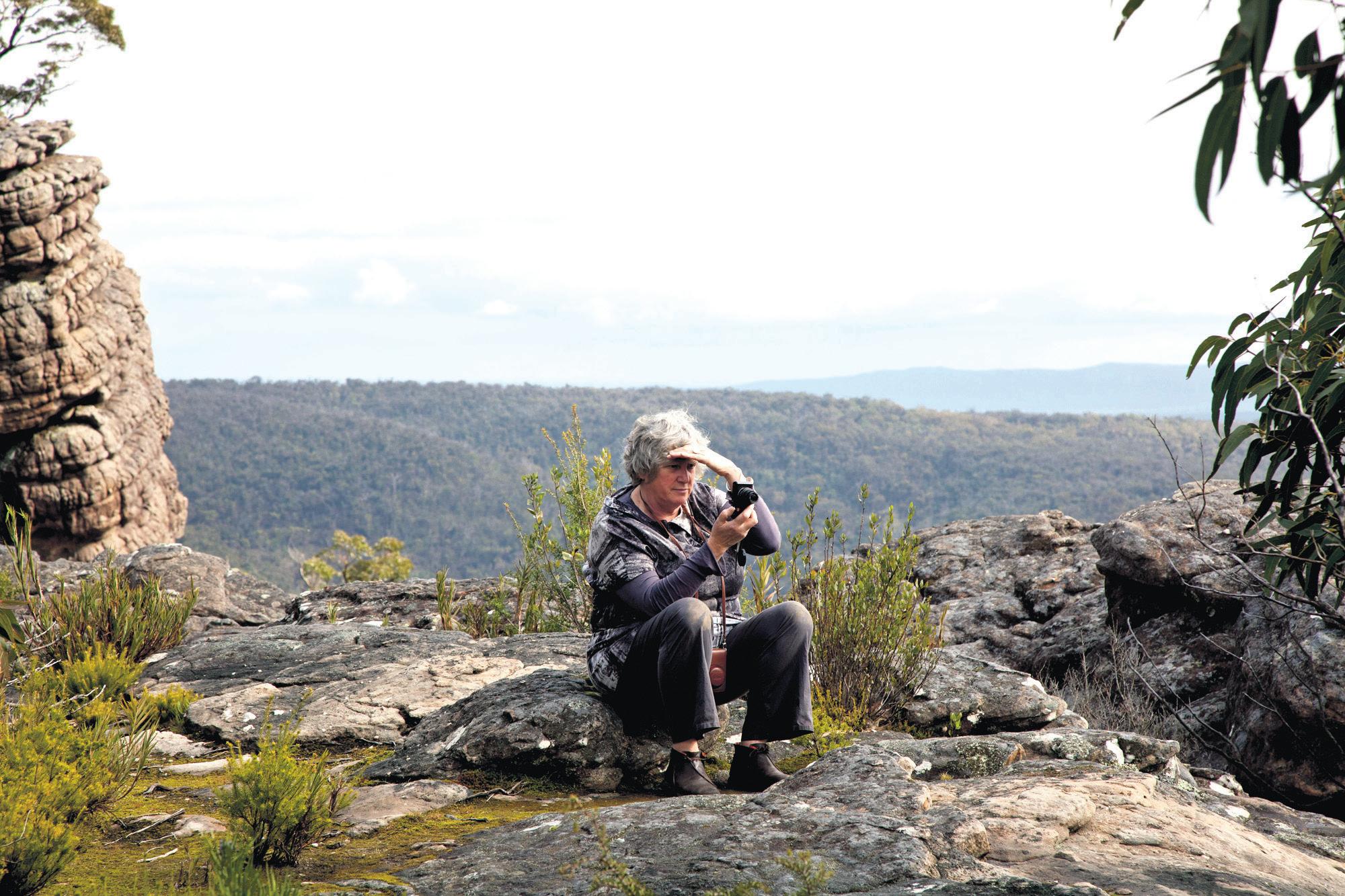
Besides creating jewellery and heading the Department of Fine Arts in Monash University, Marian likes to spend time bushwalking and swimming. Art is hidden in Nature and she likes to spend a lot of time exploring the great outdoors. “It is easy for me as an artist, as there is so much out there in Nature that can inspire me. There is always something that will motivate me to continue making more jewellery,” she said in conclusion.
Working primarily with the Australian environment, Marian claims that a part of her practice is diaristic in nature, drawing influences from her travels around the globe.
I am happy to see that India has recently seen an upsurge in the making of contemporary jewellery designs that draw on the country’s tradition and heritage

NATIONAL EDITION INDOPHILE
PREETI JABBAL
Clockwise: Marian on the mountainside Silver vessel Necklace
HOW TO ACE YOUR UMAT!
This week, Dilshan breaks down each section of the UMAT exam and explains what it takes to master them. Dilshan graduated from Baulkham Hills High School in 2008, with a UMAT score in the 100th percentile, and a UAI (eq. ATAR) of 99.95 . Dilshan currently studies Advanced Science/Medicine at Sydney University and teaches for the Medstart Program.
If you’re looking to enter Medicine or the other health sciences, you will need to ace the UMAT exam. Your scores in UMAT are used as an essential criterion in selecting students to study Medicine and Health at University. As ACER states, UMAT is hence a ‘high stakes tests… the results [of which] have the potential to make a major impact on the future career of the test taker’.
In this article, we will examine:
• How the exam is structured
• The Importance of speed in the exam
• Review each of the section & the particular type of thinking they test

Unlike your HSC, which is knowledge-based or curriculum-based, the UMAT exam is skills based. In each of its section, the UMAT exam is testing a particular type of thinking. Moreover, to score the top marks, you need to complete UMAT questions quickly and accurately.
HOW IS THE UMAT STRUCTURED?

Section 1:
# of Questions Time (mins) Avg time per Question (secs)
Logical Reasoning 44 65 88
Section 2:
Understanding People 40 50 75
Section 3: Non-Verbal Reasoning 38 50 79
THE IMPORTANCE OF TIME
Before examining each section in greater detail, it is important to emphasise: The UMAT exam is a race. That is to say, most students could score much higher marks if they had more time. Given an extra 30 minutes to 40 minutes, you’d be able to get a lot of the “harder” questions. However, if you are not careful and do not complete all questions, you will instantly lose marks. This is one of the biggest differentiators of UMAT – it test not only how well you think, but how quickly you think and without a calculator.
Again, this is very different to the HSC, in which you almost always have enough time to answer questions. Good exam technique is therefore critical. If you can arrive at the correct answer by quickly eliminating “wrong” answers, you can create a time advantage to ensure you finish the exam. In the Medstart Program, we teach our students systematic frameworks to breakdown the tpical question types quickly and accurately to ensure they develop the critical time advantage in the UMAT exam.
SECTION 1 – LOGICAL REASONING
Section 1 is essentially divided into two types of questions:
Problem Solving: which involve solving a hypothetical situation or “logic game”, given certain clues and conditions: AND

Logical Reasoning: infer facts and draw logical conclusions based on stimulus material that is of a general scientific nature. Logical reasoning questions take three forms:
• Verbal Reasoning: involves drawing logical conclusions from a passage

• Data Interpretation: involves inferring facts and trends from a variety of tables and graphs
• Scientific Experiments: involves understanding how facts can be inferred experimentally, and assessing the validity of experimental method and conclusions.
As a health professional, you will need to infer facts and draw logical conclusions from the research and other articles you read, as well as to diagnose patient’s symptoms etc. It is therefore appropriate that a section of the UMAT tests your ability to reason, given a known set of facts.
SECTION 2 –
UNDERSTANDING PEOPLE
Section 2 tests your ability to understand about people: how they react in a variety of interpersonal situations, and what they are likely to feel. Nicknamed “The Empathy Section”, Section 2 aims at testing how well you can recognise the emotions of another person in a given context. ACER suggests that this should help screen doctors who can empathise and communicate with their patients.
Section 2 questions generally fall into three categories:
• Doctor-Patient Interactions, i.e. whether a doctor has appropriately responded to a patient’s concern

• Dealings with death, sickness or disability, where a patient or his/ her family member reflects upon their dealings with adversity
• Emotionally intense situations, including situations like spouses arguing, children arguing with parents, unfaithful partners.
SECTION 3 – NON-VERBAL REASONING
Section 3 involves abstract reasoning, i.e reasoning that is entirely visual form. Like the classic IQ test, you are asked to interpret sequences and patterns of a set of shapes, in the following formats:
• Pick the next item in the sequence: You will be given four patterns that change according to a rule. You need to decipher the rule and determine the next in the sequence
• Arrange the sequence and pick the middle. A series of 5 shapes/ patterns are given to you in a random order. You need to arrange the sequence and pick the middle.
• Find the missing segment. You are given pattern with a missing segment and asked to pick one of 5 patterns that would represent this missing segment.
• Similarity: you are asked to infer a relationship between two objects/words/shapes, and apply it to a second set of objects/ words/shapes. E.g. a “Dog” is to “Wolf” as a “Cat” is to ….. In this article, we have examined the types of questions and some general tips on the UMAT course. However, to succeed in the UMAT exam, you need to know the specific frameworks – or ways of thinking – needed to answer all these question types. Our comprehensive UMAT courses will help you do exactly that, teaching you the methods to categorically breakdown every question type in the UMAT exam, provide you with Online Practice (10 Mock Exams and Practice Drills), and personalised follow up support.
If you’re looking for more than “general tips” on the UMAT exam, MedStart offers comprehensive UMAT Preparation Courses. Our focused, small-group approach to UMAT shows students how to categorically breakdown every question type in all three sections.
36 APRIL (2) 2012 www.indianlink.com.au
Go to www.medstart.com.au for a FREE full length practice exam or Contact us on 1300 998 628 or info@medstart.com.au for more information.

INDIAN LINK 24/7 RADIO Or listen live on www.indianlink.com.au letyourvoice be heARD! 1 8000 15 8 47 to subscribe* STAy CONNECTED! Tuneinathome, atwork,oreveninthecar, Andturnupthevolume! wegiveyousomethingtoshoutabout *Min.12months,$9.95pm $50refundabledeposit

38 APRIL (2) 2012 www.indianlink.com.au


APRIL (2) 2012 39 NATIONAL EDITION
Rest and repose in the
There is perhaps no other international airport on Earth other than in the Maldives where, on arriving, you have to get a boat to be transferred to your hotel.

This is because the nation comprises of numerous smallsized islands with the airport located in one, while hotels and resorts are dotted on others, the nearest being Male, the capital city, less than 2km across the water.
Ecologically fragile nation
An ecological quirk in the middle of the Indian Ocean, the Maldives is a series of ancient coral reefs that surfaced around the sides of prehistoric volcanoes.
Those immense structures have since sunk into the ocean, leaving behind coral islands of incredible natural splendour, now themselves being colonized by travellers seeking rampant pampering and romance.
For the numerically minded,
the archipelago comprises of 1,190 low-lying islands scattered across the Equator, in groups of 26 naturally occurring atolls which are ring-shaped coral reef enclosing a lagoon, a geographical feature supposedly unique to the Maldives. The total area controlled by the nation is around 90,000 square km, but most of it is under water. A population of 340,000 inhabit 200 islands, and about 100 more from the rest have been developed into exotic hideouts for tourists seeking their own hideaway, veiled from the hectic hustle and bustle of city life.
As an unfortunate victim of climate change, this paradiselike archipelago survives today standing just two meters above sea level. Unless drastic measures are undertaken, ecological pundits warn that by the end of the century the ocean will swallow all the remaining land and the Maldives will be wiped off the world map. This verdict, as a blessing in disguise, inspires many like me to step on its shores before it vanishes, to soak up its history, culture and unmatched natural splendours.
Early Settlers
Located around 400 miles southwest from India and Sri Lanka, modern Maldives boasts

of a fascinating past. Speculations indicate that earliest settlers were Dravidians from South India, Yakka and Naga from Sri Lanka and Aryans from the Indus Valley. Being on the sea route to India, it later became a meeting point of Arab, African, Malay and Indonesian mariners. Maldavian faces reflect all of these influences, contributing to a cultural and racial melting pot. Once ruled by Sultans who accepted Islam as their religion from the Arab traders in 1153, the nation has remained independent all through its history except for a 15-yearlong occupation by the Portuguese in the mid 16th century. However in 1887, it signed a protection treaty with the British to prevent Borah merchants from Bombay shifting their interest from business to government. The arrangement ended in 1965 with the Maldives becoming a Republic three years later.

Capital city Male
Home to one third of the nation’s population, Male is an interesting place to visit. Said to be the world’s smallest urban capital and obviously thickly populated, life bustles in this 2sq km island along its waterfront promenade, flanked on one side with key administrative buildings including the President’s office, and dotted on the other with several jetties from where boats depart for the airport and other islands. At one end of the stretch is the main market selling local produce including seafood, while on the other rests an artificial beach, a favourite spot for locals to swim, chill out or play impromptu football matches. Both locations are ideal to experience a taste of the Maldivian lifestyle and shake hands with locals, who speak good English, though their national language is Divehi,
which contains Arabic, Sinhalese and Indian influences. Other sites of interest are the National Museum, Grand Friday Mosque, Old Friday Mosque, Tombs of former Sultans and flower-filled Sultan Park.

Central to all of this is the Traders Hotel, a five-minute complimentary boat ride from the airport. It is the best accommodation in town where a highly recommended spa treatment gets rid of the jetlag syndrome and prepares you for a once in a lifetime tropical escape in one of the Maldives’ 100-odd privately owned luxury resorts.
Luxury hideouts
Most Maldivian resorts maintain a distinguishing class of their own that express nothing but the epitome of luxury. The Taj Exotica, Anantara, Angsana, Four Seasons, Banyan Tree, One & Only Reethi Rah are just few from the long list that are favourites among celebrities and holiday makers who look for the best of everything.
However in 1972 when tourism began its journey here, Kurumba Maldives surfaced as the nation’s first privately owned resort and still remains an exotic hideout of distinctive style and panache. Only 10 minutes from the airport by boat, this classy resort promises to captivate guests with an unparalleled choice of accommodation facilities, dining experiences, leisure activities and entertainment, while maintaining idyllic refuges and quiet spaces for relaxation to create the perfect balance for a holiday in paradise, ideal for all, from newlyweds to families with kids. For years it has been the resort of choice for visiting heads of states and world leaders, most recent guest being the Indian Prime Minister Dr Manmohan Singh, who stayed there on his way back home after attending the SAARC conference in the Maldives.
In any Maldavian resort the sun, sea and sand are the three simple realities that engage tourists from far and wide to experience their own ‘Robinson Crusoe’ island getaway, sleeping either in a thatched roof bungalow directly on the beach or in a water villa on stilts in the lagoon.
A veritable paradise on Earth, this enchanting country offers temporary sanctuary that may well be short-lived
TRAVEL
HOR
Maldives
A population of 340,000 inhabit 200 islands, and about 100 more from the rest have been developed into exotic hideouts for tourists seeking their own hideaway, veiled from the hectic hustle and bustle of city life.


Main picture: Ocean view dining

Clockwise from top: Resort setting
The Maldives is a wedding hotspot Marine life is bountiful


Local girls are pretty but shy Infinity pool at Traders Hotel Minaret of Male’s Grand Friday mosque
The underwater scenery around the resorts is so rare and enchanting that most guests take up snorkelling and diving, even if they haven’t ventured into it earlier. The resorts provide adequate training, necessary gear and expert guides to take one through an unforgettable undersea journey. You see a great variety of colourful fish, corals and other unknown but inviting marine life. As the lagoon water is shallow, other kinds of water sports such as wind surfing and jet skiing are also possible. If water sports are not for you, other recreational facilities keep you engaged like the lagoon-sized large swimming pools, tennis courts, ping-pong tables, spa treatment and even a library to supply you with books if reading is your tool for relaxation.
“I am bored!” is never heard from anyone in these exotic nests. If none of these so-called leisure activities are inspiring, you will suddenly realise the sublime pleasure in doing nothing but simply lazing around and enjoying the scenic vistas around. The unadulterated serenity of the place will soothe your body, mind and soul. Many high-flyers from round the globe land in Maldives just for this.
Ultimately what makes a Maldivian resort stay unforgettable is the extraordinary level of pampering and indulgence offered by the friendly staff. Their caring presence and attention to detail works its magic, guests feel relaxed and at home all the time. It’s said in any Maldavian resort, you arrive as guests and go back home, leaving family behind. It’s surely true for Kurumba!
Great sailing around the islands
TravEl noTEbook
MALDIVES
GETTING T h ERE
Singapore Airlines (www.singaporeair.com), has daily flights to Male from Singapore with excellent connections from Australia offering 107 flights per week in total from Sydney, Melbourne, Brisbane Adelaide and Perth. The A380 operates on two of four flights from Sydney and one from three flights from Melbourne. accomodaTI o N
Characterized by a contemporary style, the 14 storey high, 117 room, Traders Hotel (www.tradershotels. com) is most visitors’ choice.
RES o RTS
Spaced on 48 acres of landscaped garden, Kurumba (www.kurumba.com) offers excellent packages to suit individual styles and budgets. Some of the region’s best diving sites are around Kurumba.
TRI p adv IS o R
Alcohol is strictly prohibited in Male, you can’t step on its land carrying alcohol, even duty free stock. However in the resorts, alcohol is served. Australian passport holders can get a tourist visa on arrival.
c URREN c Y Maldivian Rufiyya MVR, 1AUD = 16 MVR LKR



Walking by
A coastal walk along Sydney’s eastern beaches can be leisurely and scenic, but above all, interesting
BY PETRA O’NEILL
At 17, I travelled to Sydney for the first time on the overnight train from Melbourne, staying with family friends at Bronte in the eastern suburbs. Later, I lived there in the days when it was still a knockabout beach suburb. On Friday evenings, I’d walk to Bondi for a swim and pizza, and take home a thick creamy slice of decadent Hazelnut Torte from the Gelato Bar.
The eastern beaches coastal walk from Watsons Bay to Maroubra is one of Australia’s great walks, best done in several chunks on sunny days when the sky is bright blue and the locals are out swimming, surfing or fishing. You will follow the Pacific Ocean with waves crashing against rocky cliffs below and walk by historic swimming baths, rock pools, trendy cafés and restaurants.
Beginning at Watsons Bay, you can look across the heads to Manly and visit the site where the Dunbar sailing ship crashed during a severe storm in 1857, carrying 63 passengers and 59 crew. Only a young sailor who clung to a ledge for 36 hours, survived.
The walk continues past Macquarie lighthouse, Australia’s oldest continuously operating lighthouse with spectacular
the
views towards Sydney Harbour. This area was once inhabited by the Cadigal aborigines, and rock engravings here depict fish and whales. The walk includes coastal vegetation of banksias and heath providing a habitat for small reptiles including skinks. The section from Clarke Reserve to Bondi is challenging, with many steps and cliffs of up to 80 metres.
Bondi, thought to be named after an Aboriginal word meaning the sound of breaking waves, is Australia’s most famous beach.

The art deco style Bondi Pavilion was built in 1928 and surf lifesaving began here in 1906, the club at Bondi being the world’s oldest.
The Bondi to Bronte walk follows a cliff-top path that links two of Sydney’s best beaches, past glamorous Tamarama Beach. The walk has some steep steps, but otherwise is easy. Avoid joggers with attitude. Humpback whales can be sighted from May to July and September to November, while Sculpture by the Sea is held annually. You will pass the famous Bondi Icebergs Club, whose members swim all winter and the Icebergs Restaurant where celebrities mingle.
At Bronte, the small crescentshaped beach is generally rough.
At the southern end are the Bronte Baths that opened in 1887 and the bogey hole, an aboriginal word meaning to bathe, a natural swimming hole. Historic Bronte House is located here, built in 1845.
The walk continues past Waverley Cemetery established
Sydney’S Scenic walk
B ON d I TO cOO
g EE
further information
* For maps that can be downloaded, go to walkingcoastalsydney.com.au
* For additional information waverley.nsw.gov.au or randwick.nsw.gov.au

* Buses are the best way to access the coastal walk, allowing you to make the return journey. Go to sydneybuses.info or phone 131500.
D inin G
Bring a picnic hamper to enjoy at Clovelly, Bronte or South Coogee. BBQ facilities are provided. At Bondi, locals favour the cafes along Hall Street and Glenayr Avenue or at North Bondi, along Ramsgate Avenue. The Gelato Bar on Campbell Parade is a requisite stop for Hungarian cakes to take home. The Icebergs Restaurant offers fantastic views, great food and considerable wow factor guaranteed to impress. There are many cafes across from Bronte Beach, always busy with a trendy clientele. For a more local feel, head for the quirky shops and cafes along Burnie Avenue and Clovelly Road, Clovelly, The Spot, located along Perouse Road, Randwick or Charing Cross in Waverley. in si D er tips
Only swim at patrolled beaches between the flags. If you are not a strong swimmer, the baths will suit. Wear a hat, apply sunscreen and bring a water bottle. Bondi has a farmer’s market on Saturday mornings and craft market on Sunday. If native plants appeal, Randwick Council has a great nursery in Barker Street, off Anzac Parade, Kensington. If you have a desire to surf, Lets Go Surfing will get you up on a board in no time. Call 9365-1800 or letsgosurfing.com.au
in 1877, containing the graves of many famous Australians including the poet Henry Lawson.
At Clovelly, the beach is more protected and you can snorkel here. The walk hugs the coastline past Gordon’s Bay, beachside homes, a bowling club and small beaches. The timber boardwalk above peat bogs has interpretative signage of the native plant species, including bottlebrushes and banksias.
Coogee is often crowded and a little rowdy, a magnet for backpackers from the UK, but the next section from South Coogee to Wylie’s Baths is charming, reminiscent of how the eastern suburbs beaches once were. Here you will find McIvers Ladies Baths, with an entry fee “of still 20 cents,” with elderly women wearing rubber bathing caps, young children splashing about and families nearby enjoying a BBQ.
The next section is very challenging, with many steps and requires scrambling over rocks.
Maroubra is a broad expanse of yellow sand, with beachside cafes, fish and chip shops, pubs and kebab shops, reflecting a multicultural population.

One of Sydney’s best kept secrets, the eastern beaches coastal walk is high on my list of best things to do in Sydney, with the absolute musts, the sections from Bondi to Bronte, and Clovelly to South Coogee.


42 APRIL (2) 2012 Love MyCity
ocean
The eastern beaches coastal walk from Watsons Bay to Maroubra is one of Australia’s great walks, best done in several chunks on sunny days when the sky is bright blue and the locals are out swimming, surfing or fishing.




Coogee is often crowded and a little rowdy, a magnet for backpackers from the UK, but the next section from South Coogee to Wylie’s Baths is charming, reminiscent of how the eastern suburbs beaches once were
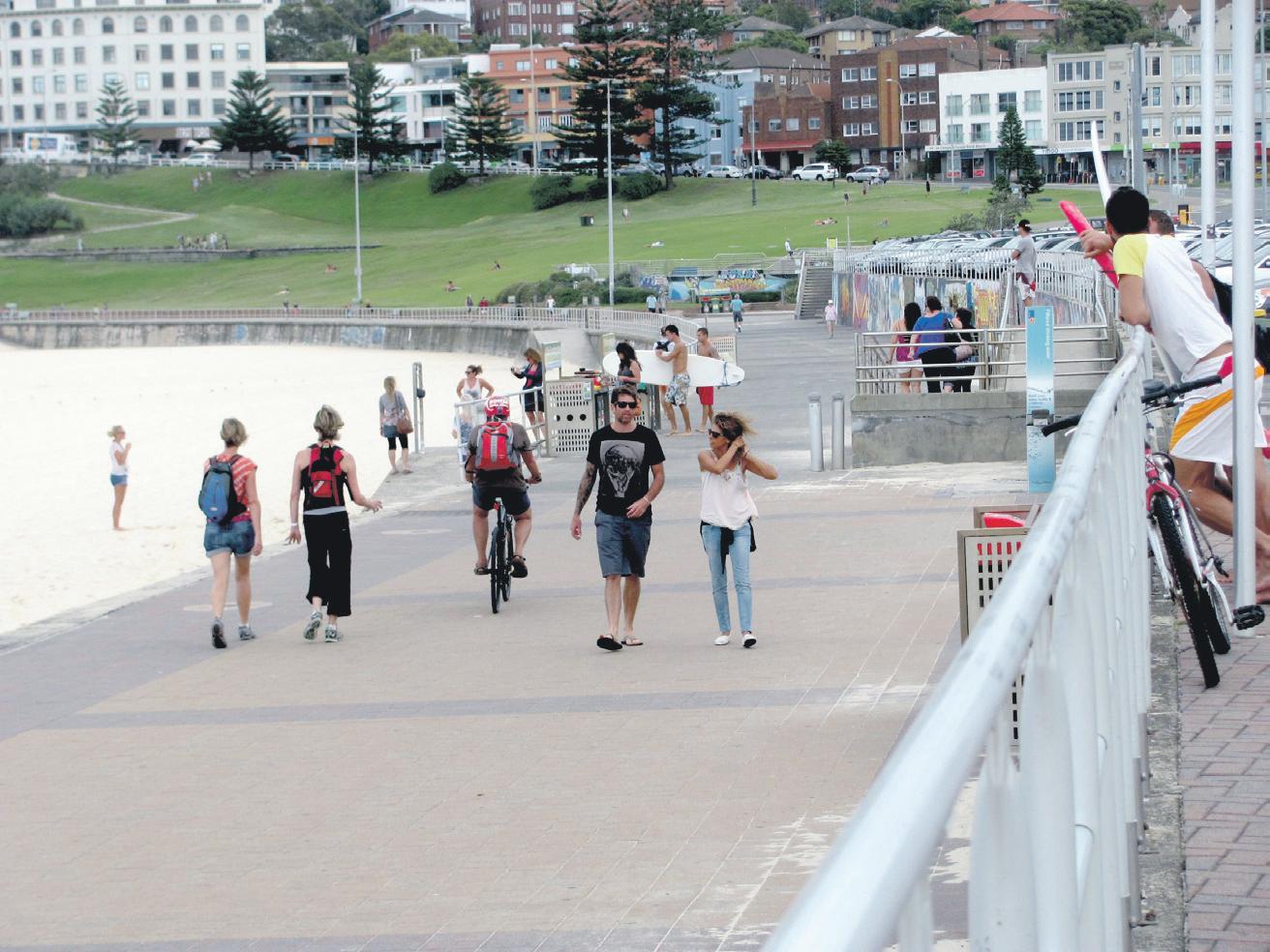





APRIL (2) 2012 43


44 APRIL (2) 2012 www.indianlink.com.au Allen 0433 398 862 Balvinder 0430 828 344 info@reex.com.au s ellin G , Buyin G , l easin G , i nvestin G ? WhY PAY M ORE ? + GST 02 96726733 reex . com . au 1% sellinG fee All types of Indian, Pakistani and Sri Lankans, Fiji tailoring and alterations. We custom sew both Indian and clothing for the entire family—Ladies, Gents and Kids. We also do home furnishings. We do fabric painting, block painting, embroidery, and other work. Call us to discuss your needs. Contact us on : 0423 663 670 / 0421 972 844 / 9864 4215 Lyndaz Indian Tailoring Visit us at : www.lyndaz.com.au
luxuriating with lavender
This
simple, multi-purpose herb can be effective for your mind, body and home
BY FARz ANA ShA
To condense its many properties into a nutshell, it is known as the ‘mothering oil’. Indeed, the healing, soothing and calming qualities of the lavender plant and its oil are so numerous and its uses and benefits so many, that this title could not be more befitting.
Apart from making your house smell like a bouquet and being one of the most popular of aromatherapy oils, lavender is a versatile herb that has been used historically as an antiseptic, anti-bacterial, anti-inflammatory, anti-convulsive, anti-fungal and anti-depressant, due to its medicinal properties.
Lavender can be used in variety

For the mind
The strong scent of lavender oil is a great stress reliever and mood lifter. Fresh or dried lavender flowers can also be used for this purpose. Just crush a few between your fingers to release their aromatic scent and inhale slowly and deeply. This has been proven to work within minutes to relieve stress, nervous tension or feelings of panic and anxiety.
To ease symptoms of depression it is recommended to try the lavender inhaler. This can be made by adding two drops of lavender essential oil to two cups of boiling water and inhaling the steam. It works wonders for inducing sleep and encouraging the mind to relax. It is also used to treat insomnia and headaches.
Lavender tea made by pouring boiling water over fresh or dried flowers, letting it infuse for a few minutes and then drinking it calms the nerves, helps you sleep better and settles the stomach by aiding digestion. For headaches and migraines, try massaging the temples with a few drops of lavender oil. Also, a few drops of lavender oil on the pillow encourage a relaxing sleep. A ball of cotton soaked in lavender oil and stuffed deep inside your pillow serves the same purpose, besides making your room smell heavenly.
For the body
Lavender oil is safe enough to be applied to the skin in its full strength. Dab it behind the ears, on the hair, wrist or anywhere on the body to smell delicious. Add a few drops of oil or a handful of flowers to your bath water for a relaxing soak.
People have used lavender oil successfully to ease muscle aches, rheumatism and arthritis and it can be used to treat stings from bees, wasps or other insect bites.
Owing to its antiseptic properties, lavender oil can be applied directly to cuts, scrapes, burns or wounds. It is soothing on rashes, bruises, blisters, cold sores and athlete’s foot. People have used lavender oil successfully to ease muscle aches, rheumatism and arthritis and it can be used to treat stings from bees, wasps or other insect bites.

Add a few drops of lavender oil to a spray bottle full of water and spray on sunburned skin for instant relief.

Lavender is also helpful in controlling eczema, psoriasis and other skin conditions.

Lavender is used to control acne and treat other skin problems. Lavender water is great for removing makeup and toning the skin, and lavender tea can be used to rinse the hair to get rid of dandruff and prevent hair loss.
To make an effective insect repellent, mix a few drops of lavender to a little sunflower oil and apply to the skin.
For the home
Lavender has many uses around the house. The stems are stripped off leaves and burned like incense sticks to perfume surroundings. A few drops of oil dripped on the filter of the vacuum cleaner before vacuuming will fill the house with a tantalizing fragrance. Potpourri and lavender sachets made out of dried flowers can be tucked in cupboards and drawers to scent clothing and repel moths.
You can make a sachet by putting a handful of lavender flowers in a square cheesecloth and tie with a string. Add a few drops of oil as well, for a stronger scent. Throw the sachet in your dryer to make clothes smell nice. One sachet can be used to scent more than ten dryer loads.
To give tiles, timber and slate floors a new shine, add a few drops of lavender to the water before swabbing.
To make ironing easy and give clothes a fresh scent, add lavender water to your iron.
Rub a little lavender oil on the light bulbs in the lamps. When the lamps are turned on the heat will release the beautiful scent.
If you have pets, use lavender as a final rinse during pet wash. This not only repels fleas, but help keep pets smelling nice.
Planted near windows and doors, lavender bushes keep mosquitos out.
Lavender is closely related to herbs like mint, marjoram¸ sage and thyme and can be used with delightful results in salads, jams, custards and cookies.
APRIL (2) 2012 45 L ifestyL e
kIR
SeeKinG GrooMS
Suitable well settled professional match for punjabi s/Brahmin girls age 23 and 25 years. serious enquiries only. email with photos and full bio data to way2divine@gmail.com
Seeking well qualified match for very fair, young looking hindu lady, 54, veg, divorced, daughter living with her. he must be aged 49-55, non smoker with strong moral values. contact lifepartner@hotmail.com.au or

0404 043 904.
Well-settled hindu family in sydney seeks a mature, well settled, good natured, professional boy from a cultured family for our charming daughter, ‘79 born, 5’2”, it professional (masters it ). caste no bar. please respond with photo and particulars to sssvjp@hotmail.com
Suitable well-settled, professional match for punjabi arora girl, beautiful, never married, 38/165, qualified it professional. Gsoh with good family values. Brought up in india.
Working in mnc sydney. australian citizen. early marriage. serious enquiries only. email details with photo to ausgirl101@gmail.com
Seeking suitable match (from australia, never married) for hindu girl 35 years, chartered accountant (non-veg), living in australia over 25 years, with eastern & western family values. please email with all details on ganesh2011v@gmail.com
L s
SeeKinG BriDeS
Seeking hindu girl, preferably Gujarati, good family values, for my son, dob 7/8/75, divorced, no children, fair, 5’8”, vegetarian, down to earth, genuine, well-built, nonsmoker, light drinker, australian citizen, tax consultant, lives with parents. contact 0423 328 800 or sydau714@hotmail.com

compatible match for 1975 born, clean shaven sikh Khatri boy, 5’ 9”, two postgraduate degrees from india and recently finished masters in i t from australia. currently on temporary resident visa (with full work rights) and doing 3 months internship at optus sydney. living with elder brother (australian citizen), and parents who are on 1 year visitor visa. Girl should be tall, well educated, with pleasing personality and must be from sikh background. early marriage and serious proposals please. contact ph. 02 9476 4570 or email: jas_ghai01@hotmail.com
Seeking a suitable match, with indian values, for 27-year-old, 5’6”, punjabi Khatri boy, permanent resident, permanent job, parents in australia for visit. please email sunaina_aqua1@yahoo.com or call 0421 959 861.
Seeking hindu girl, preferably Gujarati, good family values, for my son, dob: 7/8/75, divorced, no children, fair, 5’8”, vegetarian, down to earth, genuine, well-built, nonsmoker, light drinker, australian citizen, tax consultant, lives with parents. contact 0423 328 800 or sydau714@hotmail.com
46 APRIL (2) 2012
M atRi M onia
idiot, rascal and fool!
BY RANI JhALA
manage things, but she needed their support as she faced the new tomorrow. Later that evening it was confirmed that her husband had suffered myocardial infarction. Her parents arrived that night, and it felt good to be encircled in their arms and to know that the two people who loved her the most were there for her. Her father took over the financial matters, locating the will, meeting with the lawyers and arranging the final rites. Her mother took over the social side of things - looking after the mourners and well-wishers, and speaking to them on behalf of her daughter.
She sat and heard the praises being sung of her husband, and for hours she wiped the tears that fell. Her mother held her when the weeping was the worst. Her sons grabbed her when she fainted. On the day of the funeral she was unable to stand, and a wheelchair was brought so that she could be transported to the prayer hall.
go out with them and return to a normal life.
Just months later, her life began moving into an established routine. Her children were finally at peace and they confidently took on their new role as independent beings, just as she took on hers as an independent person. She established her friendships again. And even went on a shopping splurge. Her husband’s estate left her a wealthy woman. She had known they were rich, but never realised what her husband was truly worth in monetary terms.
Now she owned all, for he had left everything to her and the kids.
It took a while before she was truly able to stand on her own feet. But she achieved that. She took over the financial dealings from her father and she gained independence from her mother. Never were parents more proud than the moment when they saw their daughter break away from them with confidence.
opened a charity in his name. She bowed in front of her husband’s statue in reverence as the crowd cheered at the inauguration. Her sons lit the lamp in front of his photo. She promised the crowd that the light would remain lit forever.
As with the funeral, mass feeding was undertaken and clothes were given to the needy. There was not a soul in doubt that they were witnessing true devotion and felt sorry for the woman who was not yet forty, but was facing a long, lonely journey ahead of her. At the same time they also marvelled at her peace and held her up as an example.
Despite her solitary life, her parents saw that she was content. She once again laughed, but more importantly, she once again smiled. She had become human!
Soon after, her parents moved back to their own home. Their work was done. Their daughter
apart from her parents, of the abusive marriage she had endured. Of her relationship with a man who bashed her at whim, who dictated her behaviour, and who terrorised the children with his violent outbursts and insults. Nor did they know of his attack on the family maid and of the assault on his late father.

They had watched helplessly as she continued in that marriage for the sake of the children. She had said that she would not leave without them, and he would never have let them go.
But the Gods had been kind and they were now free of him. He was now where he should be and his children were in a far better place.
On leaving, her mother said, “You are better off without him. You know that, don’t you?”
“I know. I am better off and so are the kids. He will never again call me an ‘idiot’, nor will he call his kids, ‘rascal and fool’.”

NATIONAL EDITION
There was not a soul in doubt that they were witnessing true devotion and felt sorry for the woman who was not yet forty, but was facing a long lonely journey ahead of her
When the shock and surprise of unexpected loss slowly eases, other emotions come to the fore
healthy, happy, Vegebaby!
BY ShERYL dIXIT
Vegebaby. The title of this cookbook intrigued me, as I have a vegetarian husband and a notoriously fussy 5 year old, who is a staunch nonbeliever in healthy food. Author Pragna Parmita’s extremely attractive cookbook is exactly what Indian families living in Australia can look for when it comes to raising their children to be healthy vegetarians. But Vegebaby is much more than a cookbook; apart from indicating health benefits, it states what kind of food to give a child at a particular age and has answers for minor concerns which are major cause of worry for new parents. Foods that help digestion, immunity, anemia, growth, constipation, concentration, mood, memory, intestinal health or not sleeping well are all listed, as well as nutritional values for each type of food, which I personally found very helpful.

“My original desire was to see a beaming healthy child and I was aware that what I gave my child in his early impressionable years would stay with him for life,” says Pragna, who lives in the USA. “I tried what seemed like a million food combinations, set a routine and keenly watched it’s effects on my baby. The concept of Vegebaby germinated when sharing observations about the effects of certain foods and recipes with other parents, and I thought it would be great to include them into a comprehensive cookbook that could help establish healthy eating habits in children at a young age.” Mum to two boys, she experienced and observed first-hand the positive effects of greens and fresh produce on the mind and body.
Vegebaby is an easy resource guide to any health conscious parent across the world. “Along with nutritious recipes, nutrition is simply explained with the sources, the common ailments which are a cause of worry for a parent are dealt with, and all recipes include nutrient content and benefits,” she explains.
Pragna admits to researching tirelessly to make the recipes included in Vegebaby as comprehensive as possible. “I spoke to my mum, grandmum, relatives, friends, almost all

parents I knew, my nutritionist and homeopath, read books and spent hours on the internet. I then devised and tested recipes based on my son’s liking and mood keeping nutrition at the forefront. By the time I had another child, I had a better knowledge of benefits of fresh produce and it’s wonderful effects,” she says. “All the recipes are a product of what especially appealed to my children and their friends.”
I was impressed with the variety and depth of Vegebaby, and the book has received an encouraging response from India and the USA. “The common theme of healthy living and establishing a healthy lifestyle of your kids is of universal interest,” says Pragna. “I hope to reach out to as many parents as possible, not just the ones who are vegetarian.”
Although Vegebaby is not available in Australia, the e-book version is on Google Books and the book can be purchased online from Amazon. com
I noticed that the recipes in Vegebaby can be adapted for older children and even for the family meal.
Sweet potato and tomato bisque
Nutrients: Vitamins A, C, K, B, Omega-3 fatty acids, sulphur, manganese, magnesium, copper, potassium
1 tablespoon olive oil or butter
½ onion, chopped
2½ cup vegetable stock
1 cup tomato, finely chopped
2 teaspoons lemon zest
1 tablespoon honey
1 tablespoon parsley, minced Salt and pepper
Heat the oil in a pot over low heat. Add the onions, tomatoes, salt and pepper. Cook until tender. Stir in the stock, sweet potato puree, lemon zest and honey. Simmer until heated through. Garnish with parsley to serve.
Bottle gourd paratha
Vitamins B, K, protein, calcium, iron, potassium, manganese, magnesium, Omega-3 fatty acids, copper
1 medium bottle gourd (seeded and shredded along with the skin)
2 cups wheat flour
½ cup soy flour
¼ cup flaxseed meal
1 tablespoon sesame seeds
1 tablespoon coriander, minced
1 tablespoon olive oil
2 teaspoons carom seds
2 teaspoons turmeric powder
1 teaspoon asafetida
Oil/butter for cooking
Butter
Salt
Combine all the ingredients in a large bowl, along with the olive oil. Knead to make semi-stiff dough. The water in the bottle gourd will bring the dough together. Additional water should be used sparingly as it might make
finely chopped
¼ cup tomatoes, peeled, seeded and chopped
¼ cup green beans, chopped into small pieces
¼ cup gherkins, chopped into small pieces
¼ cup green peas
½ cup carrots, chopped into tiny pieces
¼ sweet potato, chopped into tiny pieces
1 teaspoon cinnamon powder
¼ teaspoon turmeric powder
2 teaspoons cumin seeds
3 cloves garlic, minced
½ teaspoon saffron
the dough soft and sticky. Roll into parathas and lightly fry on both sides with a little butter over low-medium heat. Serve with a dash of butter.
Super Seven rice
Nutrients: Vitamins A, B, C, K, iron, protein, thiamine, niacin, potassium, phosphorus, Omega-3 fatty acids, calcium, manganese
1 cup rice
2¼ cups water
¼ cup capsicum,
2 cinnamon sticks
Small piece ginger, minced
2 teaspoons olive oil
1 tablespoon butter
¼ cup raisins
Few coriander and mint leaves, minced
2 teaspoons pepper
Salt
Warm the water and stir in the saffron and cinnamon powder. Set aside. Melt the butter and oil in a pan. Add cumin seeds, cinnamon stick, ginger, garlic, mint and sauté for one minute. Add turmeric powder and quickly add
vegetables, salt, pepper, coriander and rice. Saute until the rice starts to stick to the pan. Add the water, cover and cook over low-medium heat until rice is tender. Remove from heat. Stir in the raisins. Cover and set aside for a few minutes before serving. Cashews and peanuts can be used instead of the raisins.
Cottage cheese and walnut patties
Nutrients: Vitamins A, B, C, E, K, protein, calcium, potassium,
48 APRIL (2) 2012 www.indianlink.com.au foo D
A mum’s desire to feed her young children healthy vegetarian food translates into something she can share with other parents
1 teaspoon lemon juice
2 teaspoons basil paste
Salt
For the patty
¾ cup cottage cheese, grated ¼ cup carrots, shredded ¼ cup bottle gourd, shredded

1 tablespoon flaxseed meal
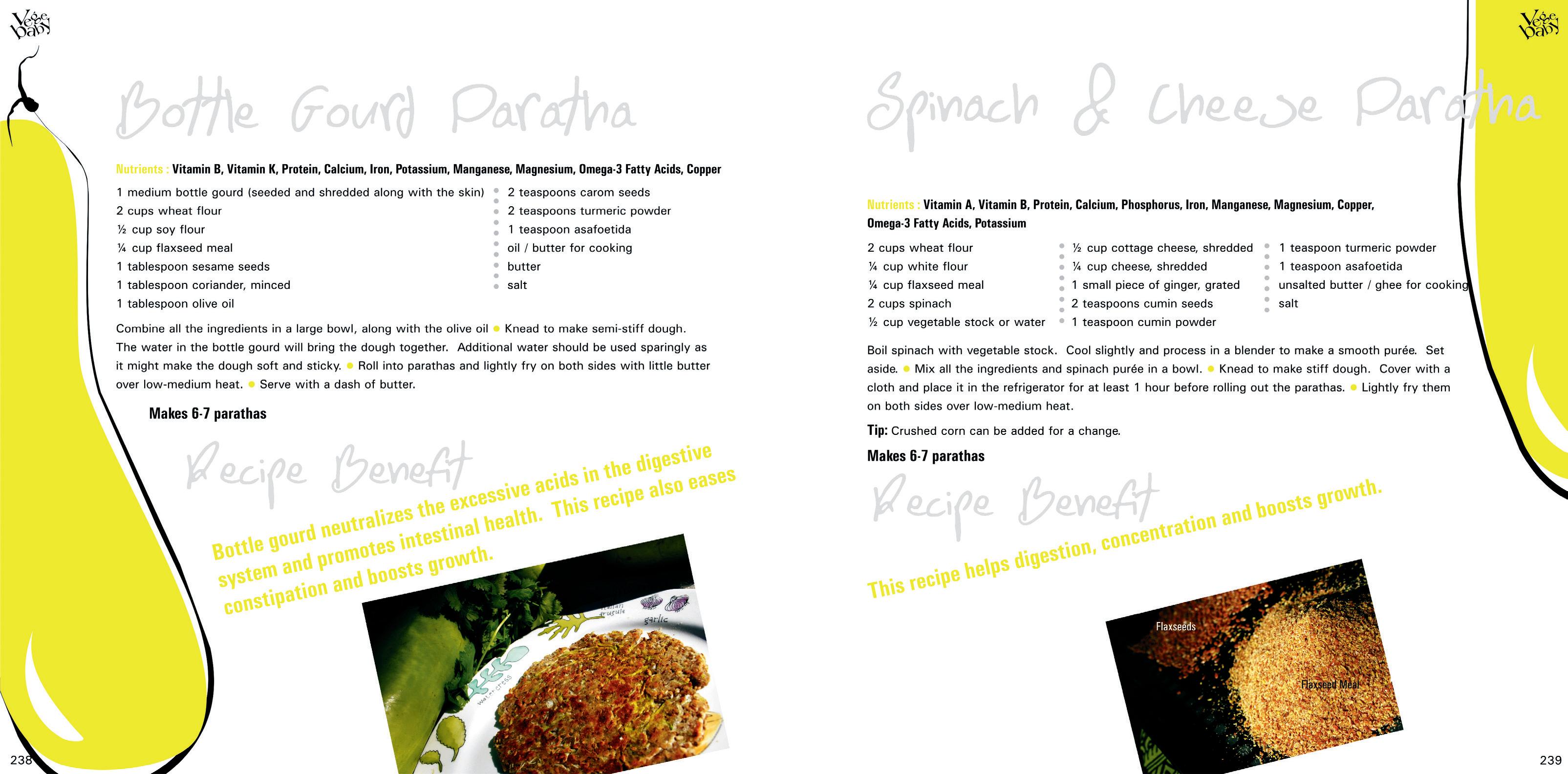
2 bread slices
1 tablespoon milk
½ cup walnuts or peanuts
Oil for frying
1 tablespoon white flour
Salt
To make the cream, blend the yogurt with garlic, lemon juice and basil paste. Set aside.
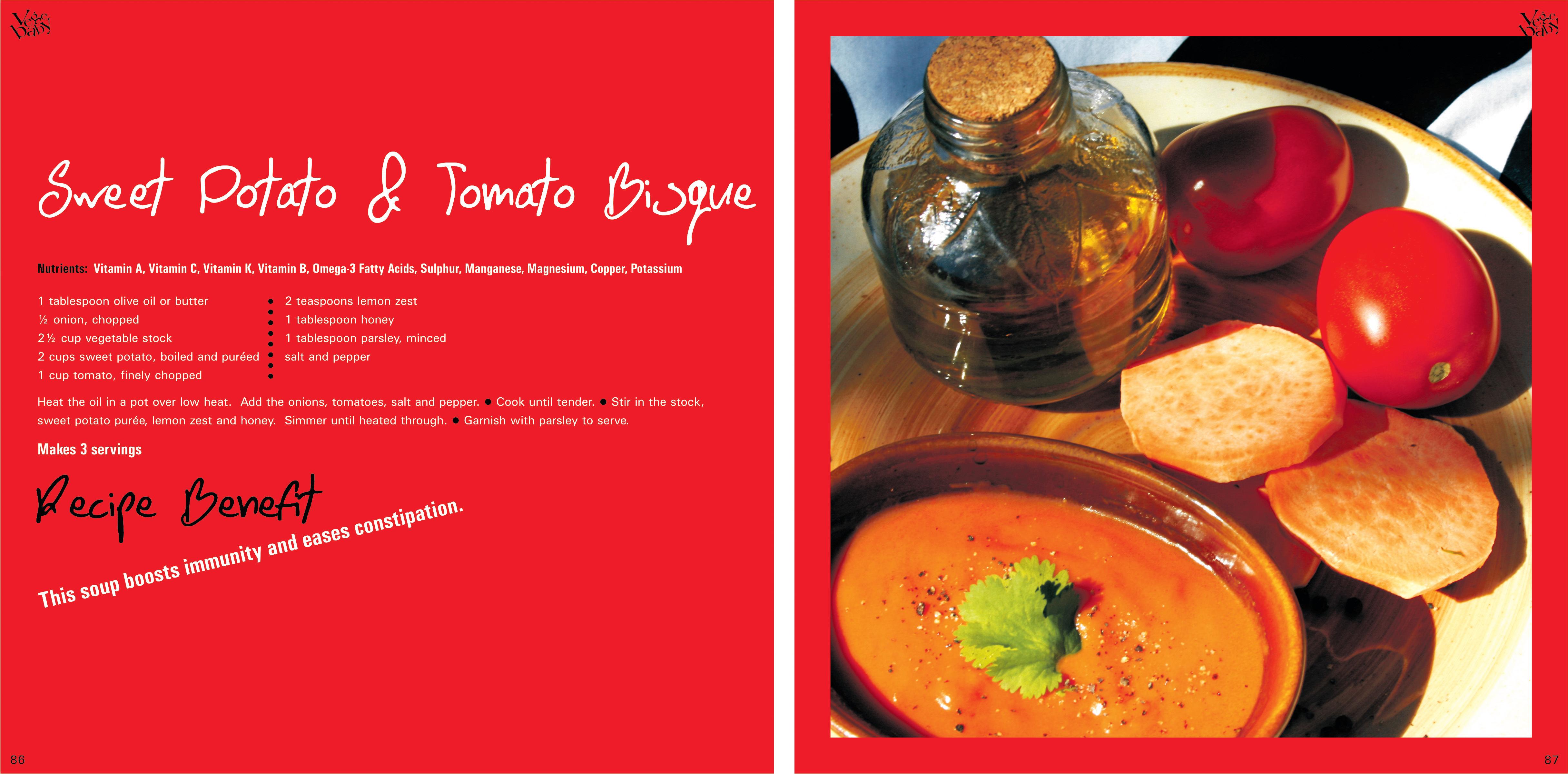
To make the pattie, heat the pan and roast the walnuts for a few minutes. Cool slightly and process in a blender. Set the powdered
in the bowl. Divide and shape into croquettes. Chill for 1 hour to firm for easy frying. Toss it in the flour and fry in the pan over lowmedium heat until golden-brown on both sides. Serve the patties with a few spoonfuls of cream. This recipe can be served with a few spoonfuls of avocado sauce (mashed avocados, olive oil, lime juice, salt and pepper).
Peanut and cardamom laddoo
Nutrients: Vitamin B, protein, manganese, copper, calcium, folate
3 cups peanuts
1 tablespoon peanut butter
1 tablespoon desiccated coconut
the peanuts in a blender. Combine the granulated peanuts, sugar, cardamom powder, coconut and peanut butter in a bowl. Moisten the hands with unsalted butter, mix the ingredients well to shape into lemon size balls to make laddos. Slightly flatten to serve.
NATIONAL EDITION
Prajna Parmita
coping with loss
There is no clinically proven method to deal with loss, but Time can be a great and comforting healer
Crying, even being alone for sometimes in the day, reliving happy memories, letting go of the loss are some of the ways to help oneself work through loss and grief
 BY SAROJA SRINIVASAN
BY SAROJA SRINIVASAN

We all experience loss at some time in our lives. We also deal with loss differently. Some want to talk about it, yet others prefer to be silent. Be it loss of money, property, employment or other material things and most of all, a loved one. If the loss is of material things we do move on within a reasonable time however large and precious it may have been, but the loss of a loved one may take much longer.
From being grief-stricken to feeling vulnerable to becoming resilient takes time, even though we experience loss at various levels constantly. We can get over some of these losses instantly and move on, yet others we find it difficult to come to terms with for a long time. Feelings of helplessness and hopelessness overwhelm us with different intensity, depending on the seriousness of loss.
Surprisingly, we seem to be able to console ourselves reasonably within a brief period when it
comes to the loss of material things or money. The loss of a loved one is much harder to accept. This is particularly so when the loss is sudden and unexpected. Feelings that are experienced vary from person to person. Feelings of shock and disbelief, overwhelming sadness, guilt and even anger at oneself and the person who is no more are all common. These feelings do not follow linearly from one to the other, but may come and go with varying frequency and intensity. Sometimes the feeling that one will not be able to cope without the loved one surfaces, but almost always it is possible to adjust to life without the person. The most fundamental truth is that grieving takes time.
Bouts of crying, sleeplessness, feeling of emptiness, unable to eat or sleep are all common reactions to the loss of a loved one. These feelings are also present when the loss is not of a person, but following major surgery. The loss of function following traumatic injury can also lead to such reactions.
Feelings of grief are different for each person and takes time to pass. There is no ‘right’ way to react because everybody deals with loss differently.
Time is the greatest healer, we hear often, and quite rightly so.
As time passes, the feelings of grief won’t be there all the time, and they become less frequent and less intense. While the symptoms of grief are the same as depression, the difference is that the process of grieving acts in a cathartic way, leading to healing in time.
There are some helpful ways to manage grief and loss that may be worth considering. First of all it is important to give oneself time to grieve and then recover. Crying, even being alone for sometimes in the day, re-living happy memories, letting go of the loss are some of the ways to help oneself work through loss and grief. Talking to some one almost always helps. Trying to hide feelings as a way of protecting someone else may not always be helpful, except in circumstances with very young children.
It’s impossible to predict how long it will take someone to overcome grief. Feelings come and go, and it can feel like you’re always taking one step forward and two steps back. For most people time is the best healer, and it may take weeks or months before you can start to accept the changes in your life.
Feeling better is a sign that you’re working through your grief and adjusting to life without your loved one – it doesn’t mean that
you’re forgetting them or letting them down.
If you continue to feel down, it may be that other things are affecting your mood. If you feel sad or miserable most of the time and have lost interest in things you used to enjoy, you may be experiencing depression and need to get help.
Some key points to remember as suggested by experts in the field highlight the important differences between grief and major depression. It is important to remember that each culture has a different way of grieving. For example, some traditional cultures have a much longer mourning period than others. This again draws our attention to not look at grief as a unitary phenomenon as if there is only one particular way to grieve.
While we may experience the following feelings at various times briefly, when they persist for a long period, it is important to talk to your doctor or a psychologist, specially if you have felt
• sad, down or miserable or irritable most of the time,
• have lost interest or enjoyment in nearly all of your usual activities
• might not doing so well at work or school, university or work
• experiencing changes in your relationships with family and friends.
While the symptoms of grief are the same as depression, the difference is that the process of grieving acts in a cathartic way, leading to healing in time

• lost or gained lots of weight
• felt restless, agitated or slowed
down
• lost a lot of energy and feel tired all the time
• find it difficult to concentrate or make up your mind
• feel worthless or guilty
• feel that life is not worth living
These feelings are unlikely to go away on their own.
50 APRIL (2) 2012 www.indianlink.com.au P syCH e
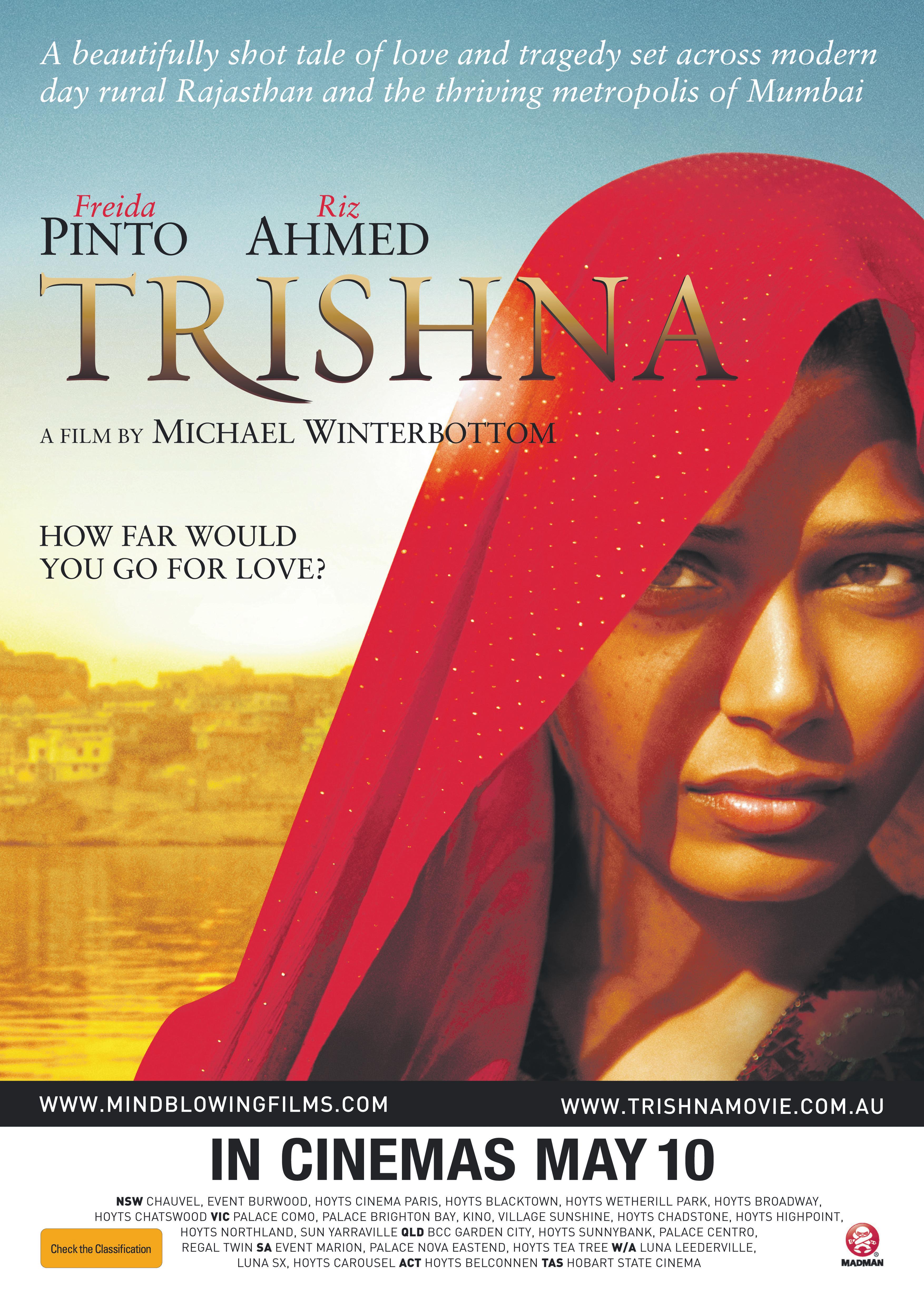
APRIL (2) 2012 51 NATIONAL EDITION
Cine Talk
Too many
characters
Film: House full 2

Starring: Akshay Kumar, John Abraham, ritesh Deshmukh, Shreyas Talpade, randhir Kapoor, rishi Kapoor, Asin, Jacquelin Fernandez, Zarine Khan, Mithun Chakraborty, Boman irani, Johny Lever
Director: Sajid Khan
gags galore. laughs?
Well, not as many as you’d expect in a 180-minute marathon mirth machine.
somehow, the jokes get choked in the comic ritual of repetition. once you figure out who’s who and who’s ha-ha in the farce fest, the attempts to cram as many characters into every frame as humanly possible begins to take its toll on the comic equilibrium of this tale of intermittent titters and some genuine laughs. so what’s Housefull 2 about? Wrong question.
Beyond a point, it’s only about keeping the embers of satire alive by hook or by over-cook. somewhere down line the witticism wears thin. But there are comic actors of terrific aptitude holding aloft the thinner segments in the farcical fabric.
Just look at the lineup. real-life brothers randhir and rishi Kapoor on screen for the first time together. Wowee! each time they appear on screen the theme from raj Kapoor’s cinema plays slyly in the background. as brothers turned enemies sharing a wall of history in ‘Great’ Britain, the Kapoor brothers take much longer to thaw and embrace one another than the other actors.
the plot is propelled forward by pairs of hostile actors who come together by the midpoint…asin and Jacqueline playing blathering bimbos who also happen to be warring cousins, seem to find no pleasure in their characters beyond swooning in their screen-lover’s arms once too
braham (the former getting the comic timing right, the latter trying so hard the effort shows) hate one another because at their college dance John caught his girlfriend with akshay in the closet.
once out of the closet the fun quotient never really stops for akshay. he is in his rogue’s element running helter-skelter between dacoit-turned-english aristocrat mithun chakraborty and his man friday Johnny lever.
the male actors get the sur of the steep satire right. But the ladies, they’re a little lost in the melee of mirth. asin who has
role among the girls is listless. making 25 faces in every frame doesn’t constitute money’s worth acting. sajid Khan shoots the ladies in exotic locations. the camera is never voyeuristic. the mood is often slapstick. But the gags never cross the limits of vulgarity. the verbal exchanges are largely free of double meanings. yup, this comedy could be watched by the family without the dialogue writing band-bajaoing papa and mama’s censorial rules.
i t is interesting to see how sajid Khan employs old traditional Bollywood
conventions, like a flashback where two friends swear to give away one another’s kids in marriage when the time is right, and an incredibly lengthy and pointless fight sequence where Dara singh’s son vindoo jumps out of a wheelchair and gets beaten up by our bunch of belligerent heroes.
such archaic formula-baazi is synthesized with more contemporary concepts of cinematic entertainment. all in all you come away from Housefull 2 with a feeling that the vast cast seems to get the
mood of riotous fun. they seem to have such fun that the audience can’t help getting infected by their non-stop party mood.
Housefull 2 takes the comic vein further than the first Housefull film. sajid’s plot, characters and situations keep the chuckle fest vibrant and alive till the end.
this is at times a wicked and funny farce with sparkling comic talent displayed by every male actor.
Subhash k. Jha
52 APRIL (2) 2012 www.indianlink.com.au
entertainment
about life Moral lesson
chhodo Kal Ki Baatein is a lesson about art of living. i t’s about living life for today. Due to circumstances, one fine day, a workaholic it professional, aditya pradhan (sachin Khedekar) finds himself reliving this one sunday over and over again. as aditya figures out his dilemma, we do, too. i t’s his routine -- sunday wake-up call followed by the events of the day that haunts him. his world is inhabited by the same people every day, but they don’t know that sunday is repeating itself. he is the only one who can remember what happened yesterday. in another sense, his tomorrow never comes.
now, trapped in some kind of time warp, aditya tries to seek help. he relies heavily on a blind man, Benaam Kumar (anupam Kher). Benaam Kumar shares his wisdom and helps aditya realise the importance of life.
the film makes the most of the sentimental possibilities in aditya’s rehabilitation. But it also has fun with the nihilism while aditya attains nirvana.
Chhodo Kal Ki Baatein is painfully witty with resonant comedy. i ts jokes are more apt to prompt gentle giggles than rolling in the aisle. though the film is basically a comedy, there are underlying dynamics that are a little deeper. the story’s premise starts out lightweight, but becomes strangely affecting and at times tedious.

much as it attempts to not sound or seem preachy, trying to support its doctrine with anecdotes and examples, the second half still ends up like a lecture in moral science. the film is packed with a storehouse of talented actors mainly from marathi theatre, and their performances are loud caricatures of the characters they portray.

sachin Khedekar is back in top form with a clever, varied role that draws upon the full range of his talents.
his character is believable and appealing. as in his previous movies, this time too, sachin makes a transition from a supreme, selfish, money-oriented, egoistical person to a nice guy, and this time he does so with particularly good grace.
the talented anupam Kher as the enigmatic blind man is disappointing. his character is not convincing enough to appeal.
also, anupam does not seem to have graduated from what he has been doing forever.
o verall, the film is conceived as a sitcom style film.
the director, pramod Joshi in his maiden hindi venture, has sensitively handled this complex theme. the film tries to resolve too many complexities of the human mind
their lives. i t sucks you in before you know it, and has just enough unexpected originality to keep you from feeling bad about enjoying it so much. a recommended watch.
Troy Ribeiro
Film: Chhodo Kal Ki Baatein
Starring: Anupam Kher, Sachin Khedekar, Mrinal Kulkarni, Atul Parchure, Anjan Shrivastava, Suresh Menon
Director: Pramod Joshi
An endearing, likeable movie
The sheer relief of watching a gifted new actor play, for a change, a good-hearted, idealistic hero who sets off to make blue films and ends up sorting out problems between couples, is enough to make us not wince at the jagged edges which stick out here, there and everywhere in the narration. the presentation could have done with some more finesse, and a lot better packaging. But hey, the heart is in the right place.
indeed Bittoo Boss for a large part ambles forward with no seeming purpose. i t opens with an elaborate punjabi wedding which, quite vocally, pays its homage to sooraj Barjatya. lording over the ‘shaadi ka dhoomdhaam’ is our endearing videographer Bittoo who shoots, in his words, not weddings but emotions, not bodies but the feelings within.
as played by debutant pulkit samrat, Bittoo is bit of a brat, but enormously sincere and idealistic. We don’t get heroes like this anymore.
the script, written as a series of episodes representing ‘Adventures In The Life Of A Small-Town Videographer’, gives the protagonist a chance to romance sleaze and then pulls him out of the morass just in time. this is a film that’s breezy but never stormy in its impact. i t works because of the director’s sincerity of intent. While most filmmakers today prefer to dwell on the dark side of heroism, debutant director supavitra Babul doesn’t shy away bringing in a shiny idealism into Bittoo’s character.
pulkit, despite an unreal hairstyle, comes across with endearing sincerity.
expressively earnest and quite impressive in his interpretation of the character’s embarrassment, he is a welcome addition to hindi cinema’s hero club.
Film: Bittoo Boss

Starring: Pulkit Samrat and Amita Pathak
Director: Supavitra Babul
NATIONAL EDITION
APRIL (2) 2012 53
the Buzz
The many avatars of SrK King Khan’s shown his true mettle, not just as Bollywood’s superstar, but also as a human being. after the detainment fiasco in the us, srK has bounced back without a worry, gaining admiration from all quarters on how he handled the entire bungle. and now, the superstar who co-owns the Kolkata Knight riders ipl franchisee and runs a film production house, said that he was not an entrepreneur but an actor who endeavors to make a difference with his acting.
“i am hardly an entrepreneur. i don’t even think of myself as a star. i see myself as someone who is trying to make a difference with his acting,” said shahrukh recently.
Sameera is Tezz
While ajay Devgn fans wait for his latest action film tezz to release soon, the actor claims that the movie’s actual hero is his co-star sameera reddy. she has done some daredevil stunts for the film, and ajay is certainly impressed by her courage.
“sameera is not the heroine, but the hero of the film. she has done some amazing action and is nothing less than any hero in the film,” he said. apparently sameera was unhappy over not being offered the item song in the film, but finally she had no complaints and enjoyed doing the stunts.

“i was not offered the item song, but i got to be ‘lara croft’ in the film. it’s an action-oriented character and a strong role. Women in Bollywood never get to perform such stunts. When i was offered the role i was told that i can’t complain that my nails are going to break. i enjoyed doing the stunts,” said the 29-year-old actress.
Directed by priyadarshan, tezz also features mohanlal, anil Kapoor, Boman irani, Kangna ranaut and Zayed Khan in prominent roles. so will other Bollywood beauties take on action roles? you bet!
“i come from a middle-class background. i like to work 18-20 hours a day and for the last 30 years i have been following this schedule. i have two passions: sports and film-making,” said Khan at the inauguration of phase one of the sprawling prayag film city (pfc) in West midnapore’s chandrakona, about 150kms away from Kolkata. he is also brand ambassador for the facility which will make a difference to the art of film making not only in eastern india, but to the entire film fraternity of the country. “i feel the film city will become a one stop film making centre where you come with a good story and go out with a great film,” said srK. the actor also regaled the gathering with some of his famous dialogues from his films Don, Baazigar and Devdas, and danced to a popular song from the movie Ra-One. meanwhile the indian government has been stern with the us regarding the srK episode, who have been abject in their apologies. Wonder if the incident will inspire shahrukh to make a movie of his experience…. new nawab to the manner born any Bollywood fan will admit that saif
GUeSS
WHo
second marriage in the offing for this bubbly singer?

ali Khan is in his element when gyrating or sprouting dialogues in a variety of big screen moments. But who would have thought that the now-nawab of pataudi has successfully established a deep emotional link with people from Bhopal that goes beyond the royal heritage. assisting him in this task was mum sharmila tagore, locally addressed as ayesha Begum, as they freely mingled with hundreds of ordinary citizens in the city of lakes recently.
saif also conferred the first mansoor ali Khan tiger pataudi memorial ‘real life hero award’ to aamir ali Khan, a former hockey player working in the field of literacy, social work and community development.
sharmila was spotted visiting mosques and gardens that were built by pataudi’s grandfather and other members of the Bhopal royalty. she was dismayed on visiting the grave of nawab hamidullah Khan in the vicinity of sofia mosque. a huge garden that was bursting with life when tiger’s mother sajida was Bhopal’s regent, is a picture of neglect and waste. sharmila wants the old glory to be restored.
saif’s last visit to Bhopal was a disaster with disgruntled elements greeting him with black flags because of a controversy relating to property issues. at the time, sharmila intervened making it clear to the Bhopal city qazi and other religious heads that their views would be honoured. the issue has now been resolved amicably. in a brief speech, saif addressed the Bhopalis saying, “i am quite moved with your initiative of starting the nawab mansoor ali Khan award for outstanding and valuable contribution. i want to congratulate you, aamir ahmed Khan - you may be an unsung hero but what i learned of you, you are our real role model. may Bhopal produce many more young men of character like aamir, and i am there to sing for your contribution.” sharmila too told the gathering, “lets us take this tiger trophy to greater heights in the times to come. i am in all appreciation for this award in my husband’s memory, who had always admired selfless, purposeful efforts.”
tournament organizer hamidullah Khan said sharmila and saif’s decision to award a ‘real achiever’ from society has gone down very well with Bhopalites. seven months after ‘ tiger’ pataudi’s demise, it seems like his son saif is ready to step into the former nawab’s shoes. and it looks like he’s going to do a good job of it. Wonder how Kareena will fit into the ‘Begum’ role, though!
Mahie is Mona
darling
the remake of 1973 superhit Zanjeer is on the cards in Bollywood, and now mahie Gill’s ready to cash in. as item songs have
54 APRIL (2) 2012 www.indianlink.com.au entertainment a BH ilaSH
a S engUPta brings us up-to-date on what’s hot and happening in Bollywood
SAM eer A re DDY
?
he will justify the role,” said mehra, son of late filmmaker prakash mehra.

priyanka will join the crew of his movie by may end.
“priyanka is busy with her other commitments. she is confirmed for the film and will join the crew by m presently we are shooting the scenes with the actors,” said mehra.
But with music a crucial part of the movie, mehra is still deciding on whom to trust with the musical score.

let’s hope mahie makes the grade that only Bindu could achieve with Darling!

Akshay on acumen and action

akshay Kumar is an entertainer par excellence, but he’s also got a pretty shrewd business sense when it comes to the movie business.
success mantra is to either make your own film or go for profit sharing.
“i have a very simple solution - make your films, because when you make your film you will not include your remuneration and it takes off the burden from a film,” recently, with a glint in his eye.
“so, when you make a film for crore and release it, the profits - be it rs.5 crore or crore - is yours.
your film won’t flop because your remuneration is zero,” added the actor, who makes film under his two banners, and Grazing Goat.
for writers who rue that they do not get their dues, he suggested, “i am making three-four films and i pay my writers well. again they can also go for profit sharing. if the film works well, they can ask for their cut in the profit.”
according to a recent report, the remuneration of Bollywood’s a-listers starts from rs.10 crore and goes up to rs.40 crore, astronomical sums by any standard. so why are they asking for so much?
“it’s neither the producers’ fault nor actors’ because producers do not know how much to give and actors do not know how much to ask for,” explained akshay. “it’s not easy to decide remuneration because sometimes a film works and sometimes it does not. so i have come to
a conclusion: make your own films,” he added, stating that hefeels “the biggest burden on a film is its artist.”
f you remove that burden, it is impossible for a movie to flop. it’s simple economics,” added the star, who has been active in filmdom for more than two decades and has about 100 films to his does not mean that the 44-yearold will not work in outside films. he will, but on one condition. “i would work in other producers’ films, but i will charge according to the film’s box office business. rofit sharing, in short. this is the only way,” he added.
arketing has become an integral part of a film,” says akshay. “it helps in the first three days of the collection, but after that, it is all about content. so one needs to focus on the script and screenplay as well,” xplaining the importance of script, think script and screenplay are more important than f your script and screenplay are in place, it is a big support for the actors.”
kshay, who started his career with action movies like Khiladi and Mohra, now returns to the genre after seven Rowdy Rathore, an action personally believe that people enjoy raw action more than technology. if you use too much of technology, it will bounce eople are very smart and understand what is real and what is unreal,” he said. o when i did my first action Rowdy Rathore after six chose to do raw action. believe in manpower and not technological power,” he added. kshay’s finally back into action…after all those comic roles, it will be interesting to see how he goes.
rrfan doesn’t like being a Khan rrfan was Bollywood’s Khan with a difference, until he dropped his surname. But the talented actor is unhappy with the way his decision is being talked about in the industry, and says being a Khan does not translate into success.

caPtion conte St
, before which he
do with each other, he said, adding, “Khan
veryone is standing on his strength.
What’s the chitchat between katrina and SRk here?

katrina: you can come closer, you know, i won’t bite
SRk: yes, but my wife can!
Bindiya Agrawal, Guildford
Other good ones
katrina: hey srK ! Who is more good looking, me or priyanka chopra?
SRk thinks: if i say priyanka, Gauri will give me hard time again.
(aloud) okay, you, only you!
Sunil Kumar, West Ryde
have been what he is today because your work counts more than the name,” he said. irrfan says Paan Singh Tomar owes its success to the public who promoted it on social networking sites.
“ the way people supported this film, and of course the media, as it received critical acclaim, mattered. But it was the manner in which people promoted it, especially on social networking sites, that benefitted this film immensely,” said irrfan. the actor has finished shooting for a european film Qissa and also The Amazing Spider Man he will soon start shooting for tigmanshu Dhulia’s Sahib, Biwi aur Gangster Returns. Well, Khan or no Khan, irfaan’s on a roll to success.
APRIL (2) 2012 55 NATIONAL EDITION
Last issue caption contest winning entry
Answer to GUESS WHO? unidhis hauhanc
What’s the chitchat between kareena kapoor and Priyanka chopra here?
SAiF ALi KHAn
SHAHrUKH KHAn
Send in your responses to info@indianlink.com. au and win a surprise prize
AKSHAY KUMAr
Ask Auntyji Ask Auntyji
Dear Auntyji
Coping with charisma Baby blues
i am an only child, and have been married for 18 months, and am about to have our first baby. i love my husband, but auntyji, each time he speaks about the baby he keeps saying that he will teach our child to play cricket and take him camping. now i am starting to wonder if i am simply a baby-making machine, and whether i will get any attention from my husband after the baby is born. tell me auntyji, why do i feel this way? Why do i feel jealous of my own baby? sometimes i get very angry and tell my husband that he does not love me any more and that i am simply a baby machine for him. of course he gets upset and he tells me that i am wrong, but i am worried that after the baby is born, no one will care about me anymore. can you please tell me how i can address this issue?

Auntyji says
Well, my little gulabo, i can see that being an only child has created a delicate situation for you. it seems that pregnancy and all the hormones rushing around has impaired your judgement. you know, your husband won’t love the baby more than he loves you. how could he – you are the mother of his soon-to-be baccha now here is what you should be thinking. finally, for the first time in your life, you are going to get someone who totally adores and dotes on you, and hangs on to your every word. finally, you will have a being in your life who sees you as the perfect human being. you will be adored, loved and cherished by this little person. so all your dreams should be coming true. What more could a self-centred person want more than someone else to worship the ground they walk on? so this is how you should be thinking of this turn of events. so if your baby adores you, and your husband loves you, surely you don’t need more attention than that, do you? revel in this attention, because the bubba will only see you as a goddess for the first 15 years of his or her life. after this, unless you are a real nice mummy, the baccha will be packing up and moving out as soon as he or she can. here is my advice to you: the baby is 50% you. so look at it this way. When your husband talks lovingly of the baby, you should feel glad. it’s practically the same as talking lovingly of you. Don’t feel jealous of your baby, otherwise you will end up being a churail of a maa a dayan and if you catch yourself thinking uncharitable thoughts about your own baby, you need to immediately make an effort to improve this. in fact, if you catch yourself feeling jealous of the baby, you should make an extra effort to be nice to your husband – as part of your redemption. this way, your husband will always be devoted to you.

Dear Auntyji
ok, i will say it like it is, because i know you appreciate honesty. i am bright and happen to have a lot of charisma, on account of being attractive. i get along with everyone, and everyone wants to be my friend. i get invited to parties all the time and apparently, i am very good company. But i am not a snob or a horrid person who talks about others – i like to think i am genuinely nice. on the occasions when i find myself thinking nasty thoughts, i catch myself and amend my thinking. every now and again, auntyji, i hear people make comments about me being shameless about promoting myself. for instance, i might discuss ideas in my class with the lecturer or i might talk to all my senior bosses. o thers who hear this might tell me that i am “brown-nosing” or that i am promoting myself. o f course, none of this is ever said seriously, and if people say it to my face, of course, we all laugh about it. But every now and again i wonder if people actually think that i am big-noting myself. i know for a fact that that is never my intention – i am genuinely a friendly and confident person. Do you think i should say something to my colleagues, or should i continue to just laugh at their comments and think nothing of it? i have not had any issues with my lecturers and bosses.

Auntyji says like mark twain, i too prefer honest arrogance over false humility, so if you are confident and friendly and attractive, then i would much rather you tell me this than pretend to be some kali kalooti who has the personality of a three day old samosa and the charisma of the neighbourhood mutt which has been tortured once too often by the bored rascals who live next door. so, here is what i hear you say. you are confident in the workplace and in school. you are bright and fairly confident. i t’s obvious that your colleagues are a little envious of you. Who wouldn’t be envious of an intelligent person blessed with good looks and charisma? so, the reason they say those things to your face is because they know you can take a joke – and i would continue to laugh at their comments while sending back a witty riposte. how lucky you are to be who you are! revel in the glory that is you, and enjoy each moment of your blessed existence, because tomorrow, you could be hit by a bus and lose it all in one go. so, give thanks for what you have, and be nice to your colleagues, they all want to be you, you lucky devil!

56 APRIL (2) 2012 www.indianlink.com.au
B aCKCH at Do you have a question for Auntyji? Send it in to GPO Box 108 Sydney 2001 or email it to info@indianlink.com.au


APRIL (2) 2012 57 NATIONAL EDITION

58 APRIL (2) 2012 www.indianlink.com.au

APRIL (2) 2012 59 NATIONAL EDITION

60 APRIL (2) 2012 www.indianlink.com.au




























 Top half: (clockwise)
1. Glenn A Baker portrait, Archibald entry, Packers Prize winner
2. Rumour Has It
3. Borneo 10
4. Elephant portraits
5. Nafisa and orang-outang sketch together
(from left)
7. Passion 1 Act IV
8. Black Burn
9. Sitting in the Passion flower
10. One of These Days You Will See Me Again
Cover visual: Let me be your one and only
Top half: (clockwise)
1. Glenn A Baker portrait, Archibald entry, Packers Prize winner
2. Rumour Has It
3. Borneo 10
4. Elephant portraits
5. Nafisa and orang-outang sketch together
(from left)
7. Passion 1 Act IV
8. Black Burn
9. Sitting in the Passion flower
10. One of These Days You Will See Me Again
Cover visual: Let me be your one and only











































































































 By TALIA KAUR
By TALIA KAUR


































































 BY SAROJA SRINIVASAN
BY SAROJA SRINIVASAN





















